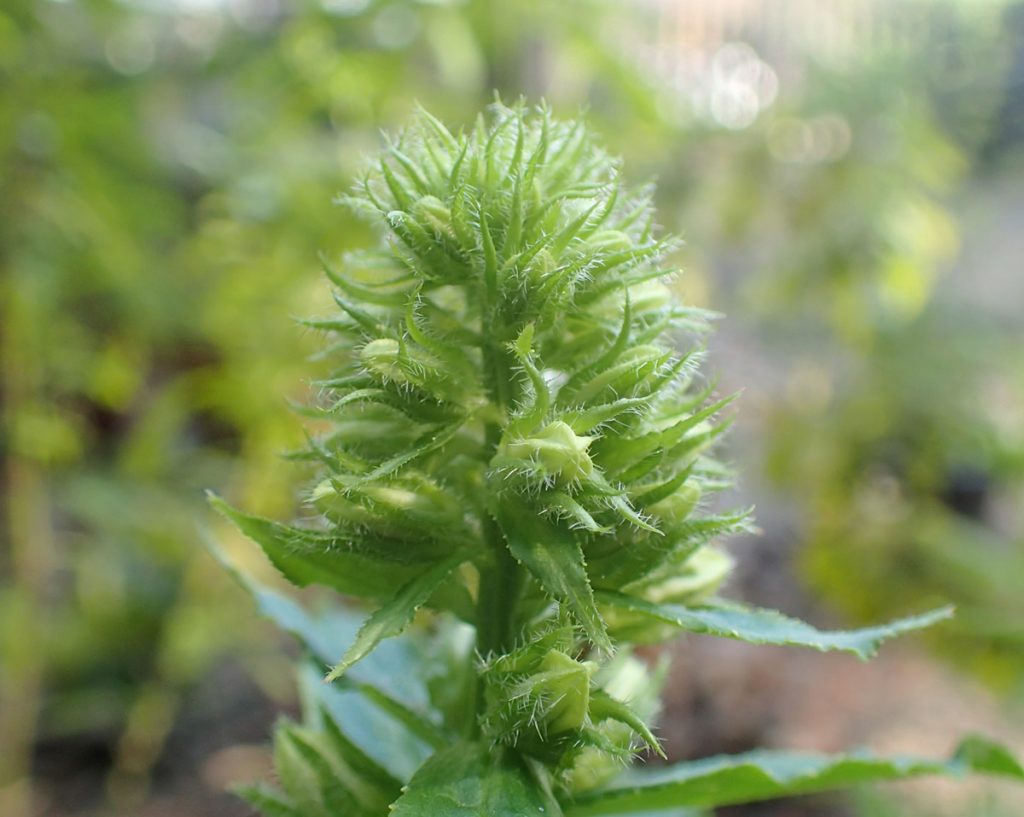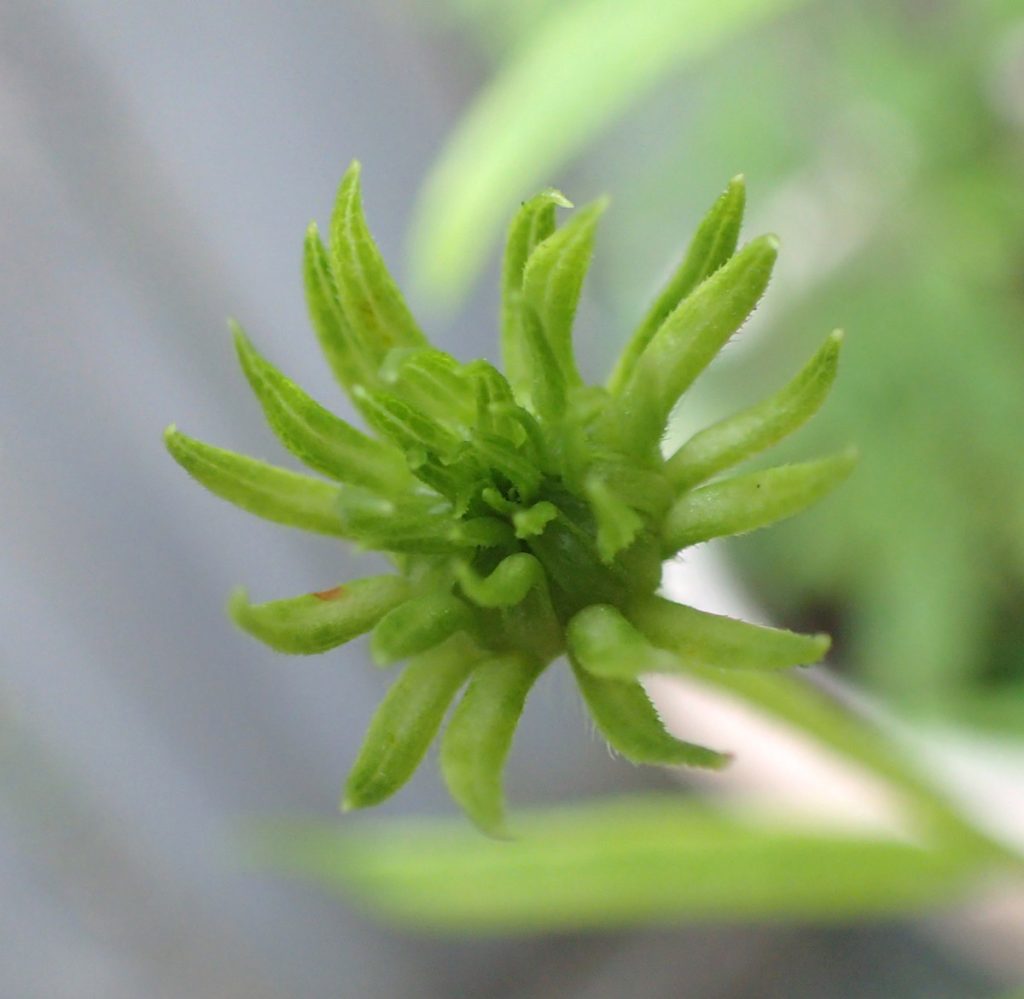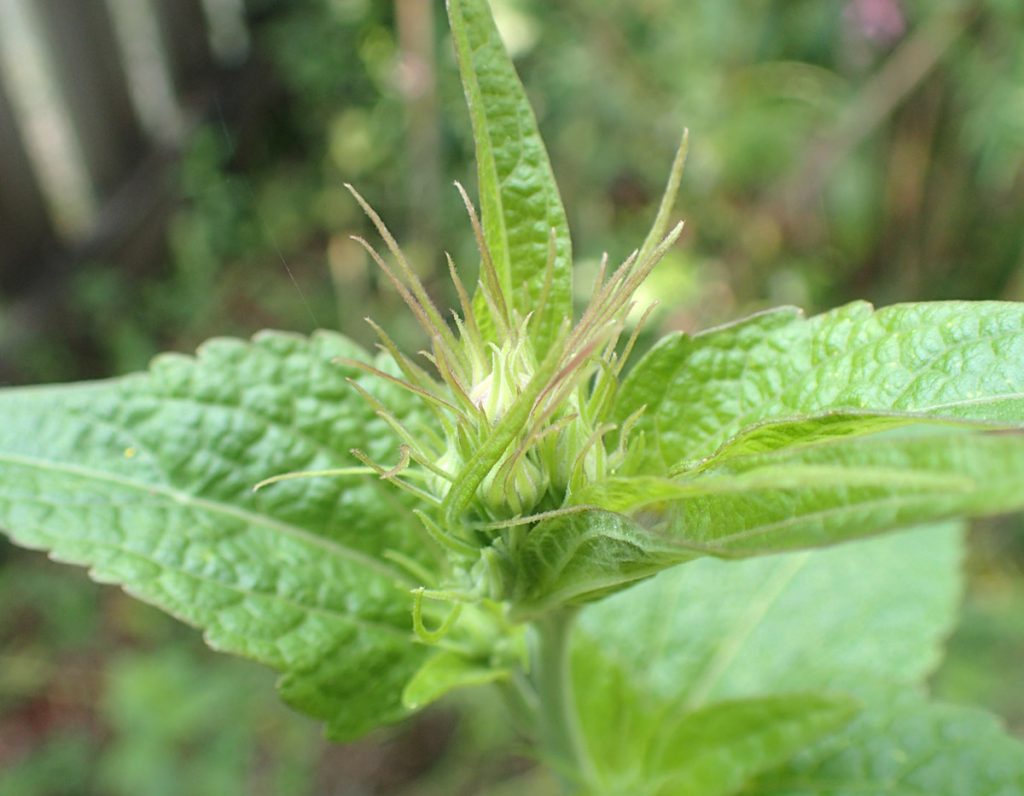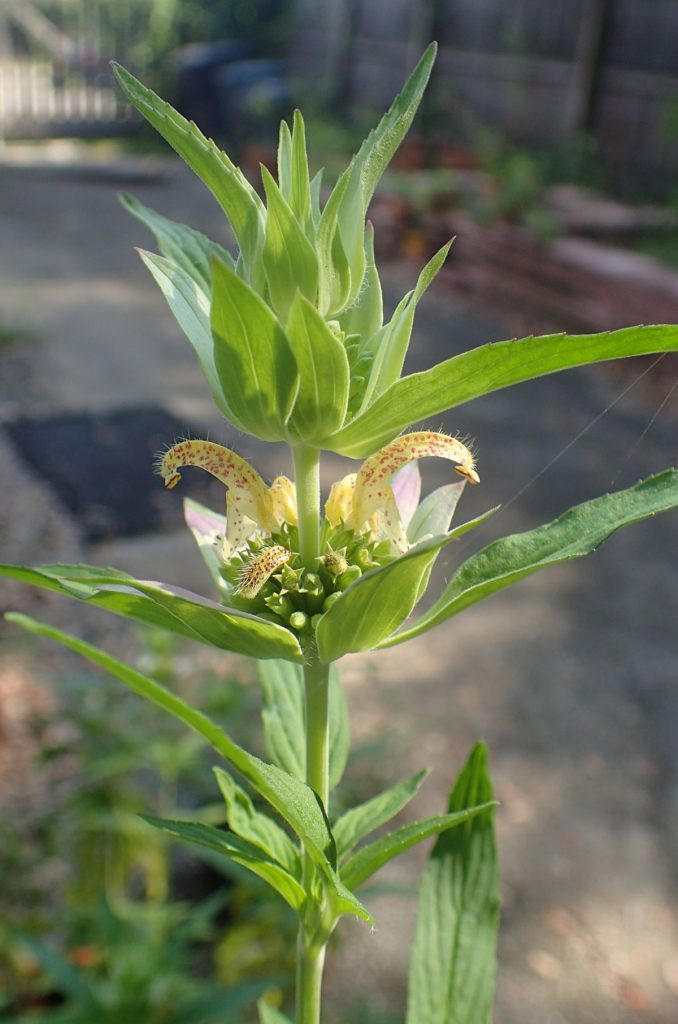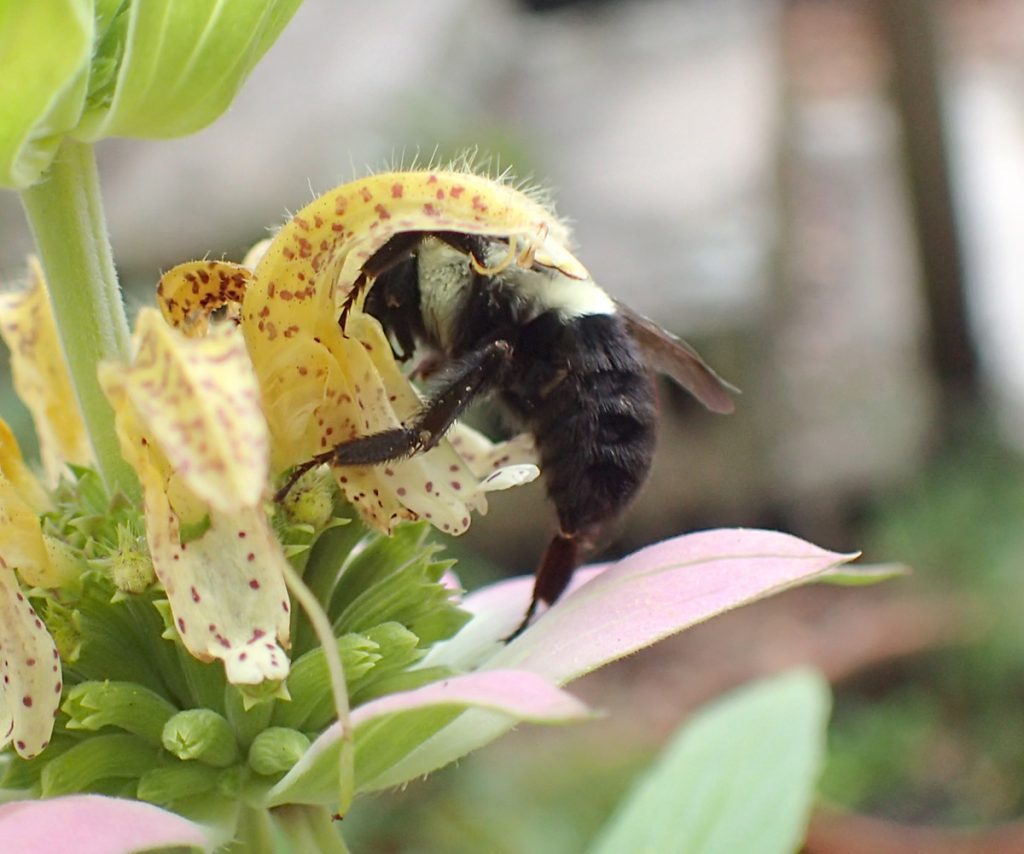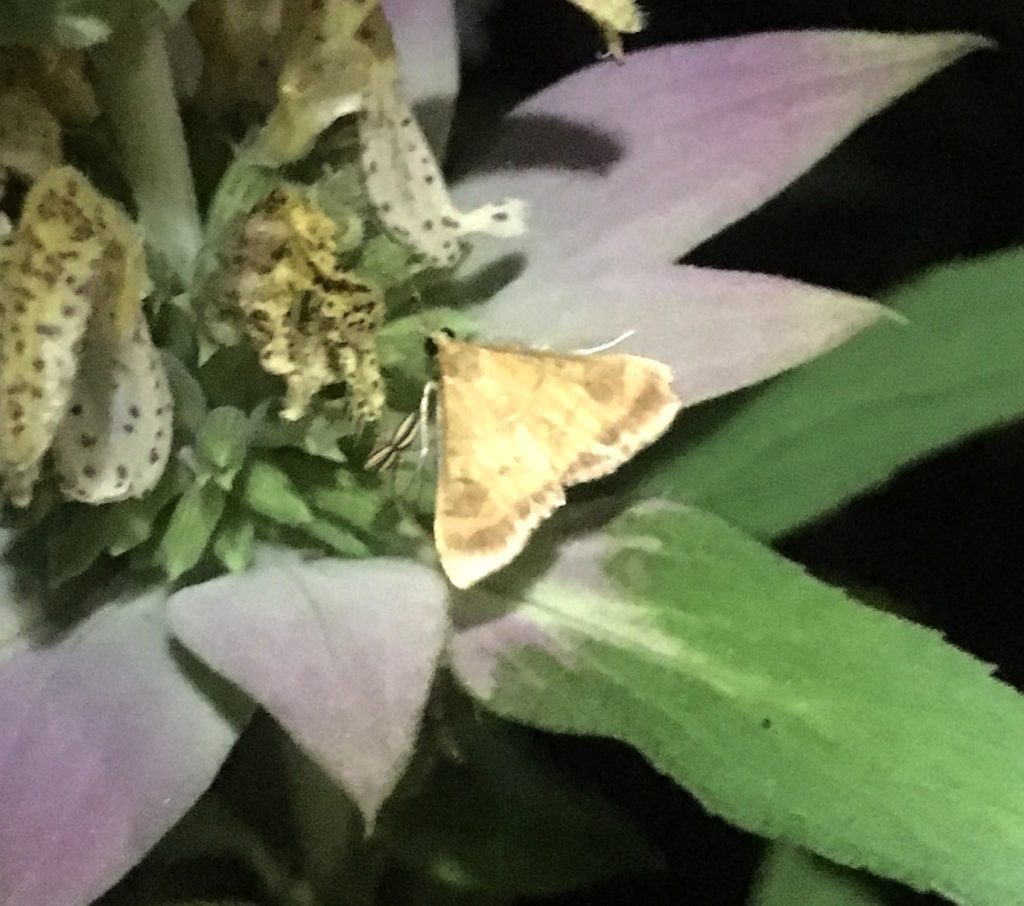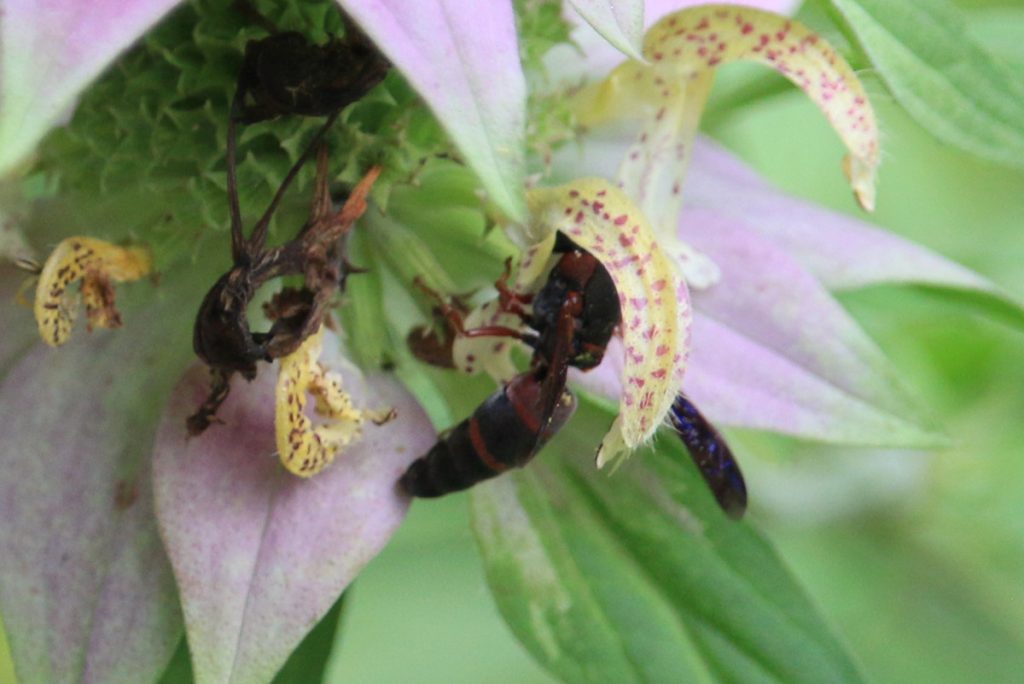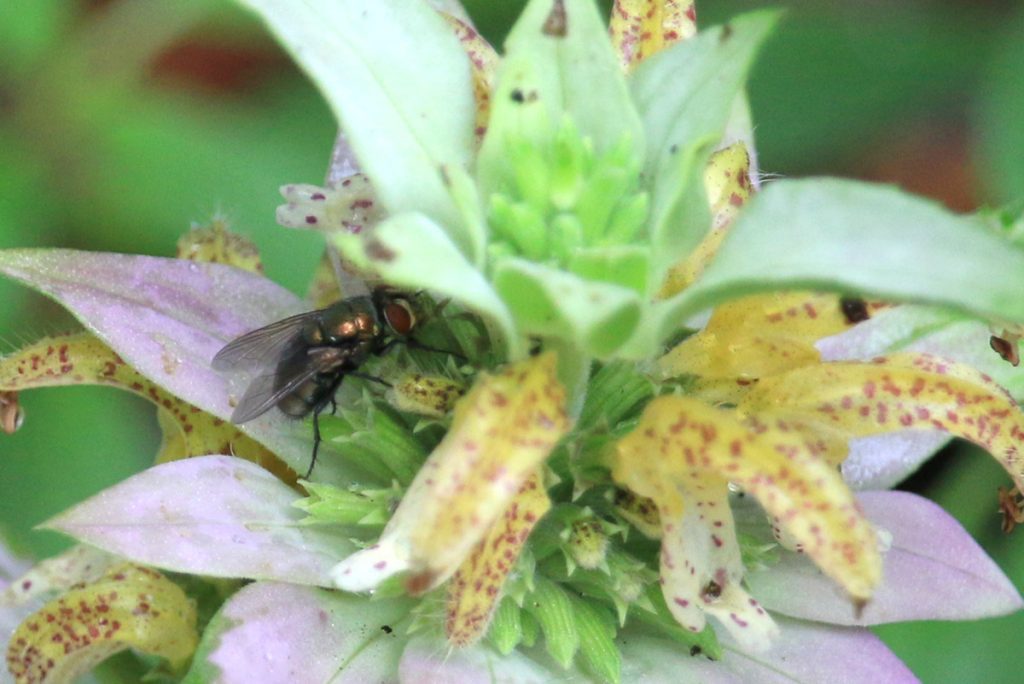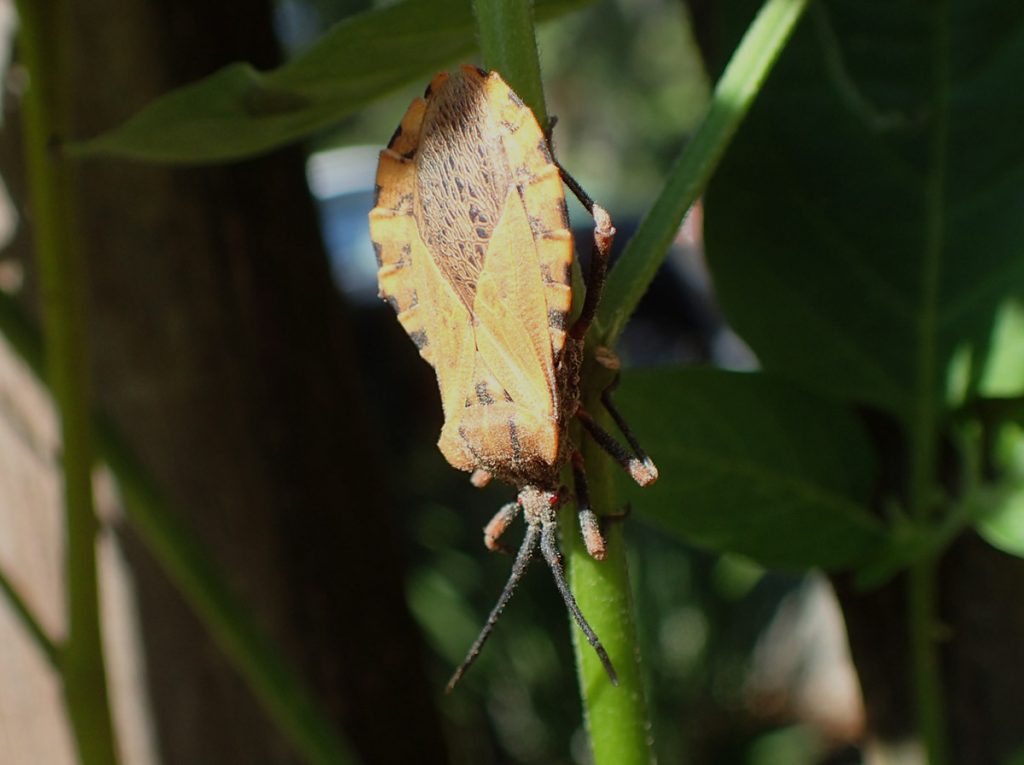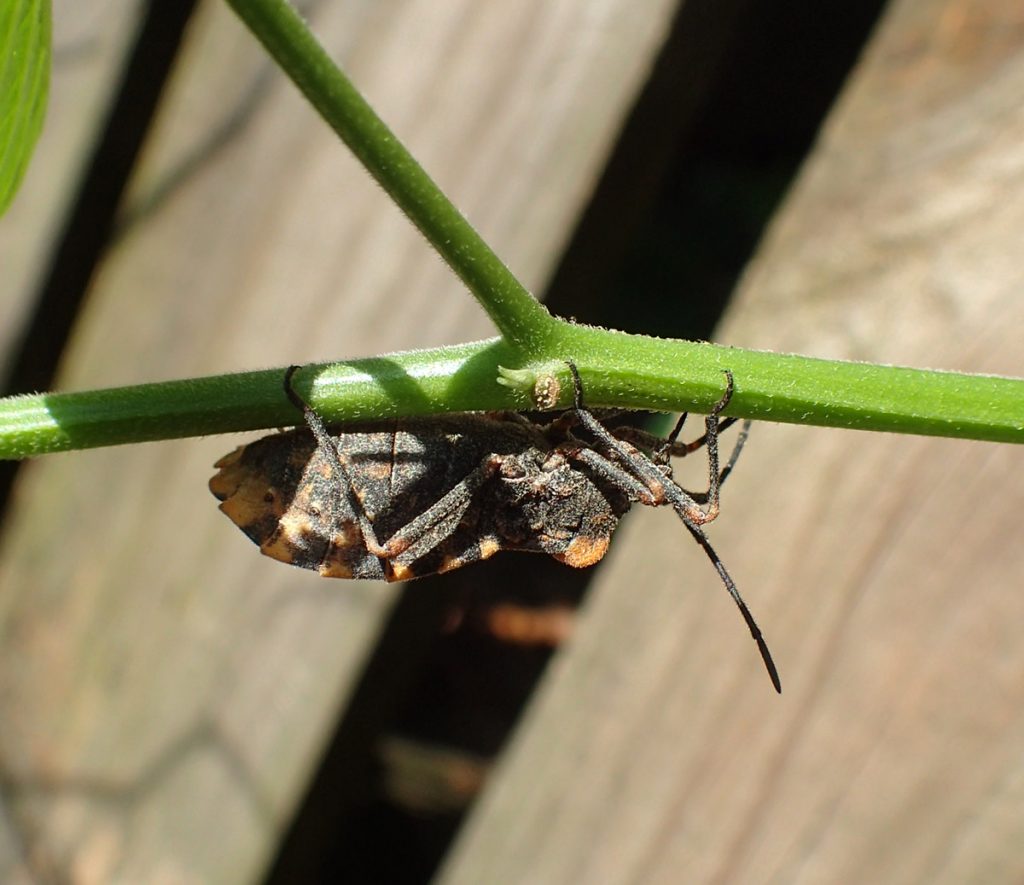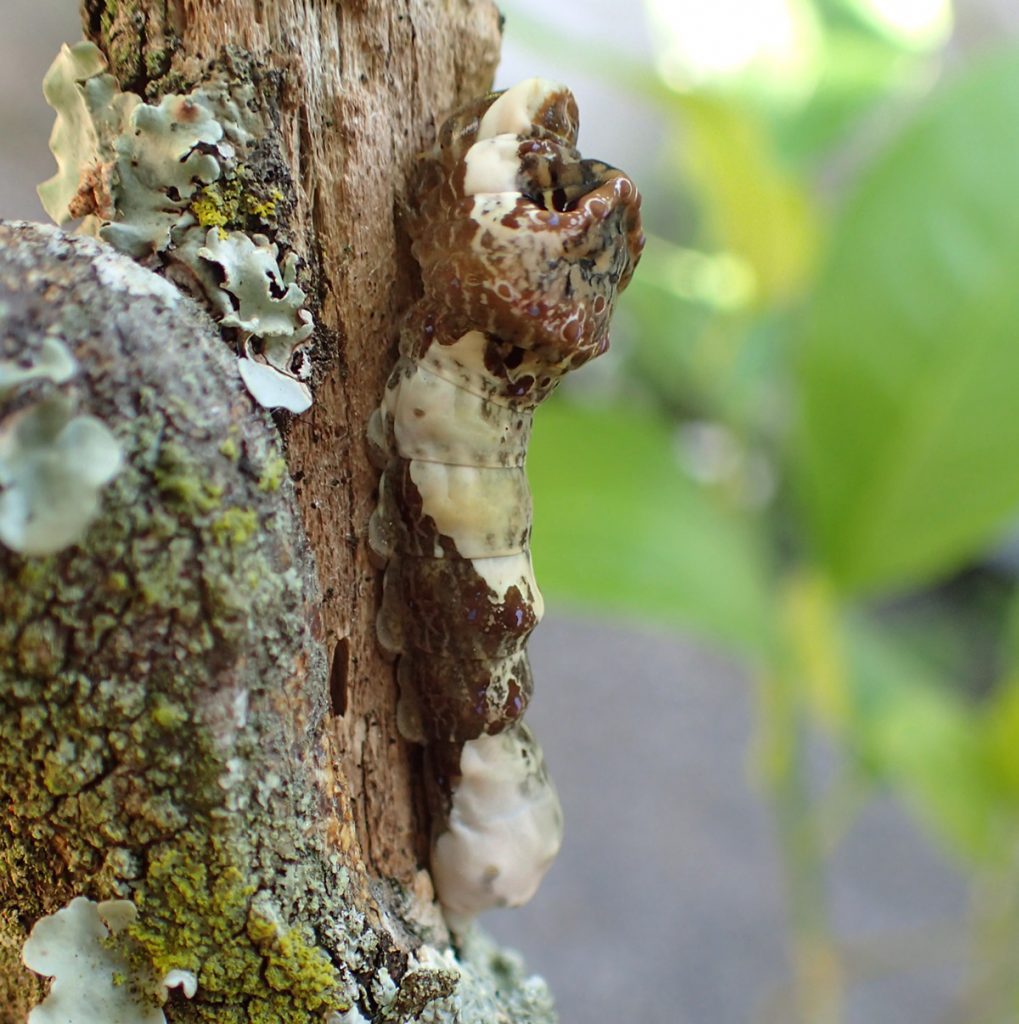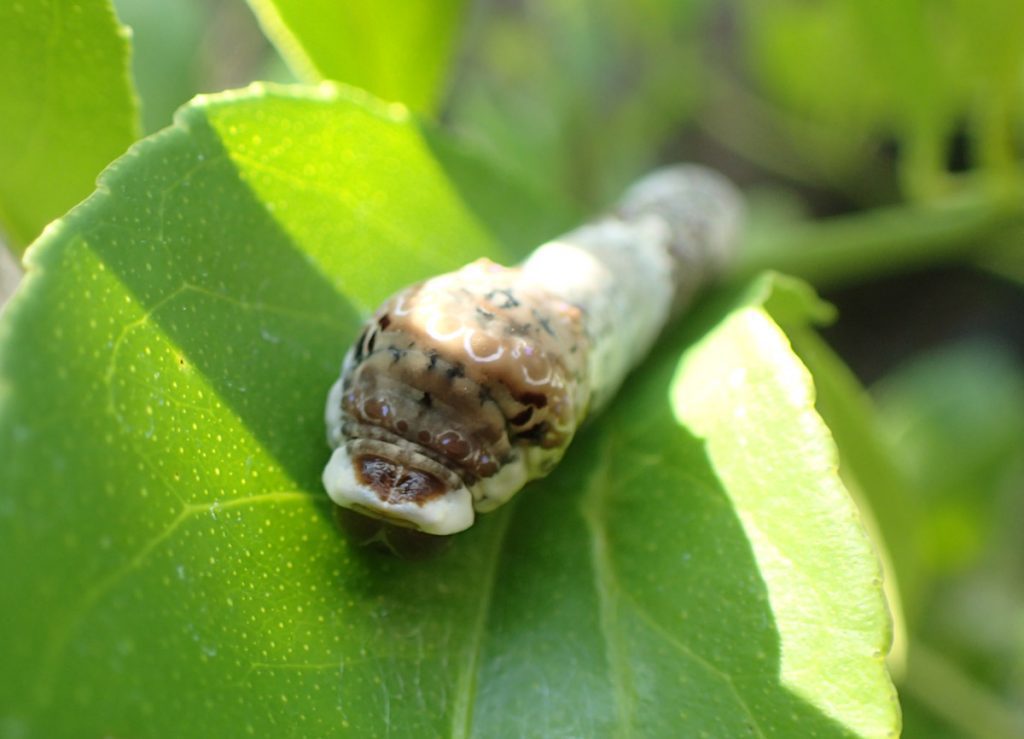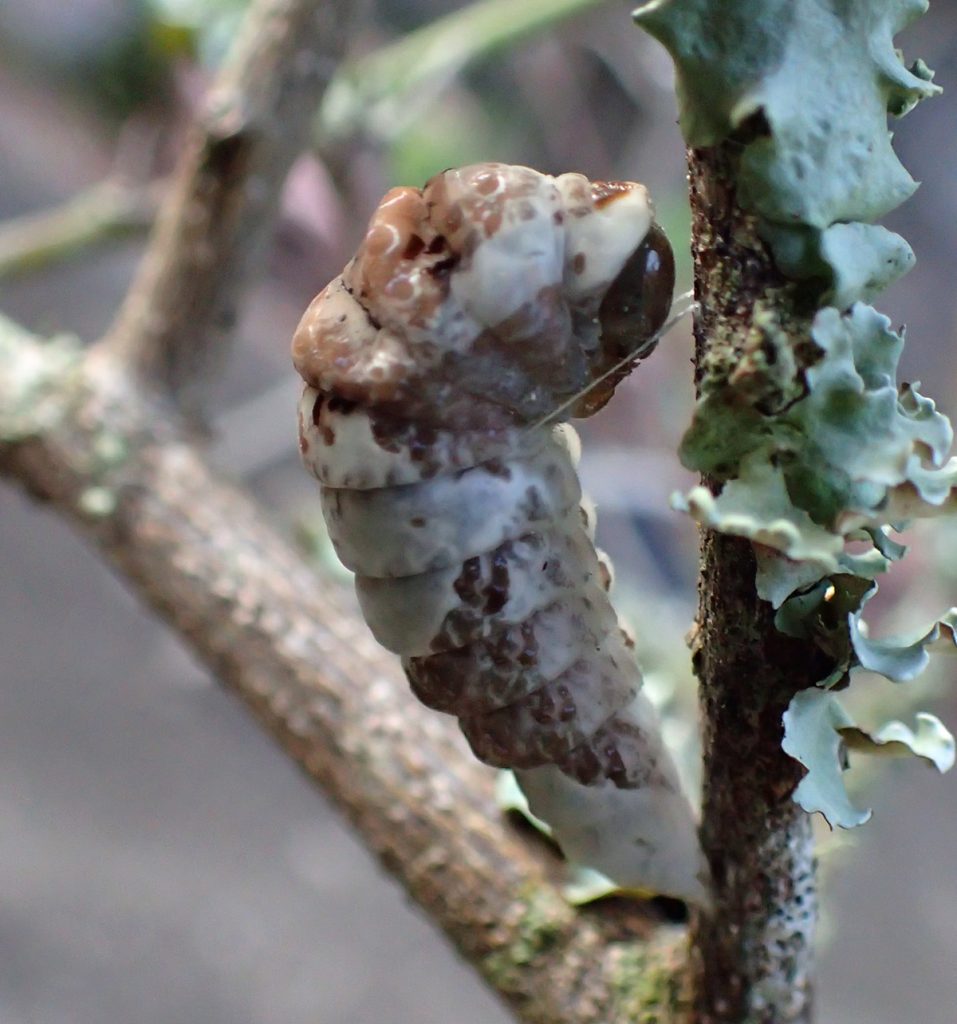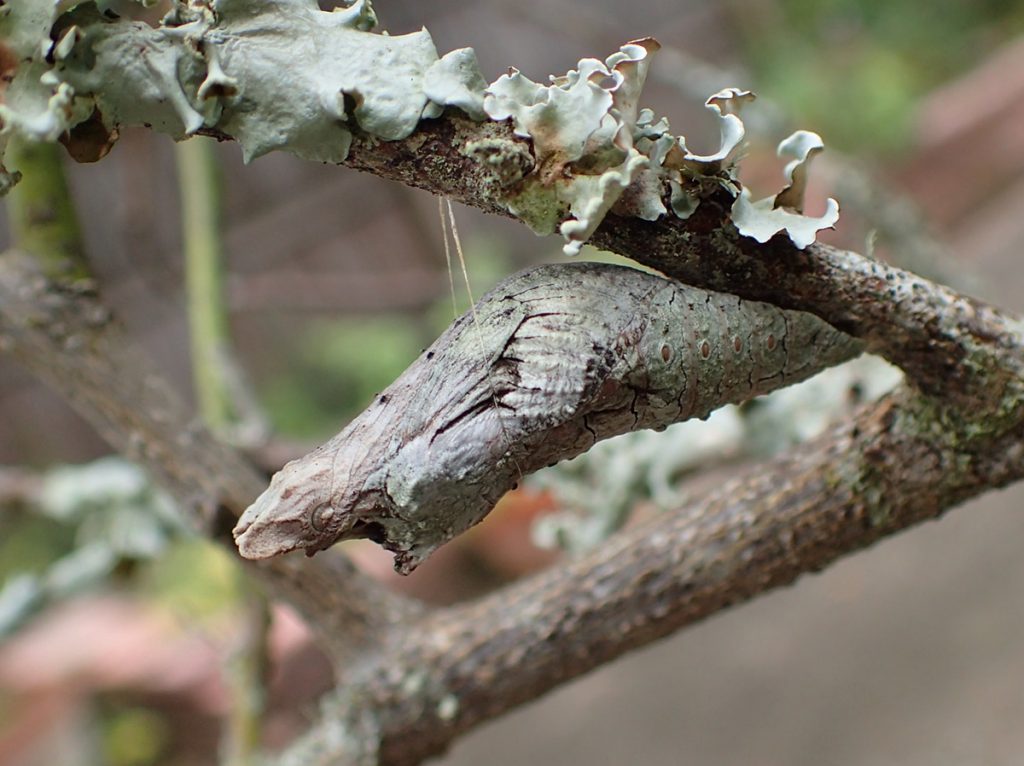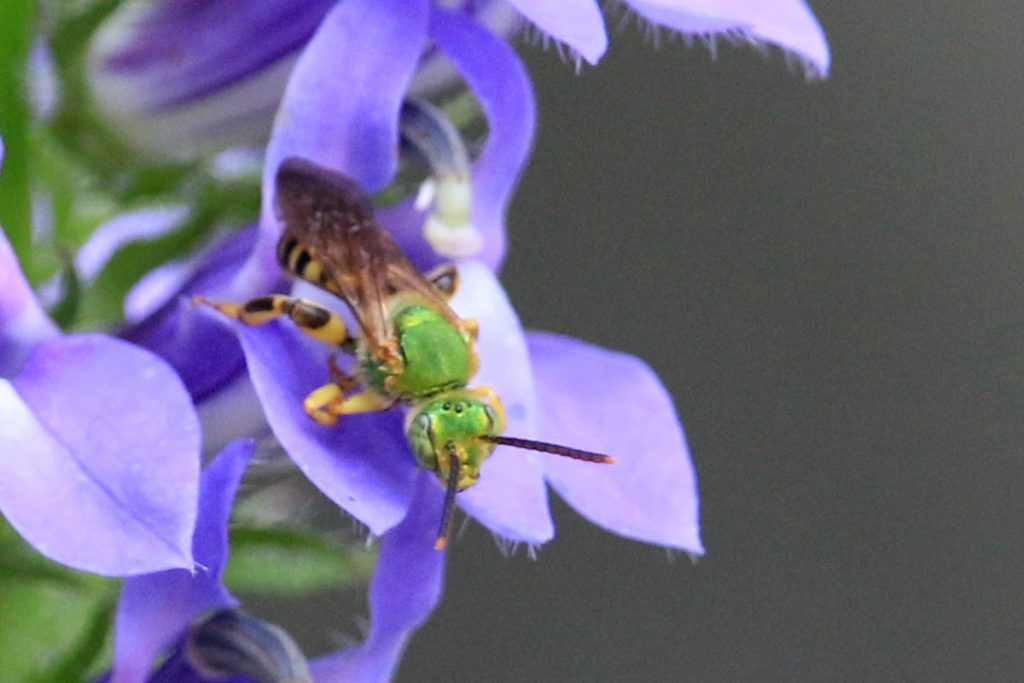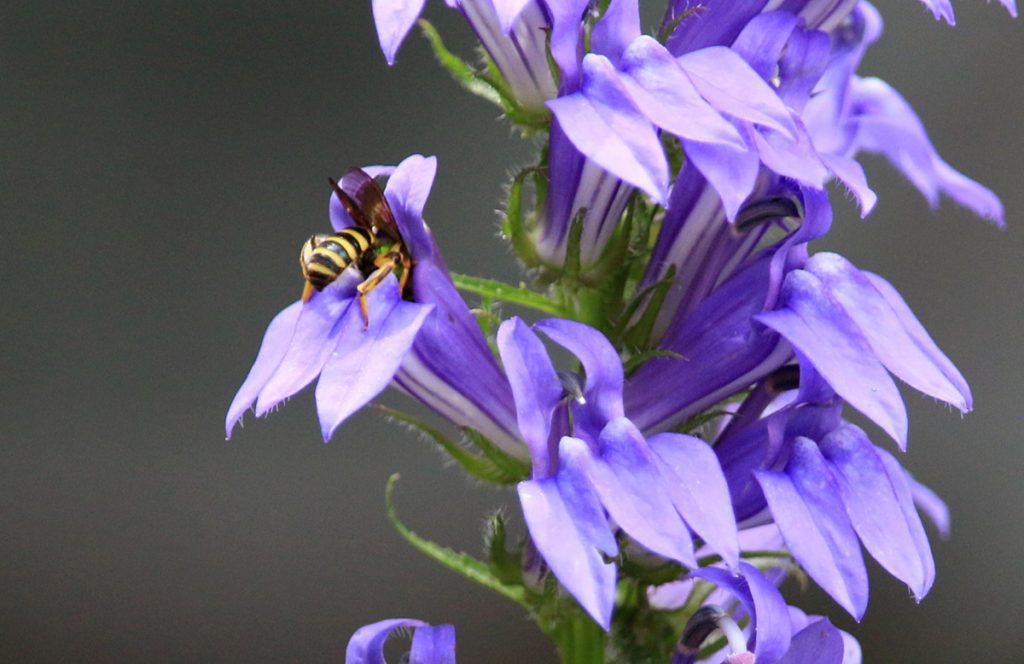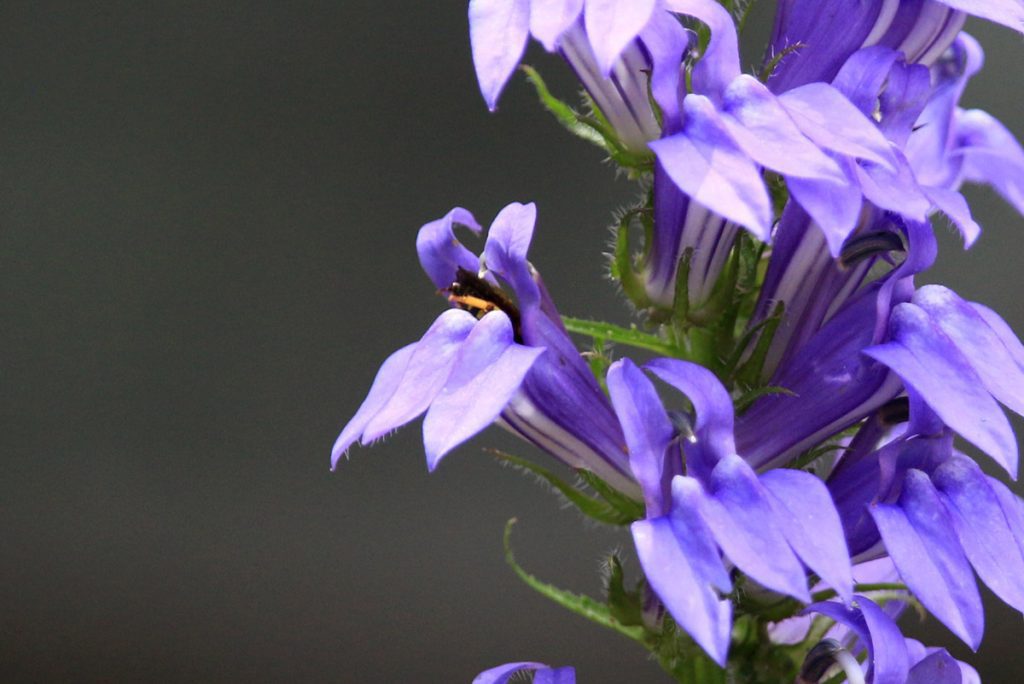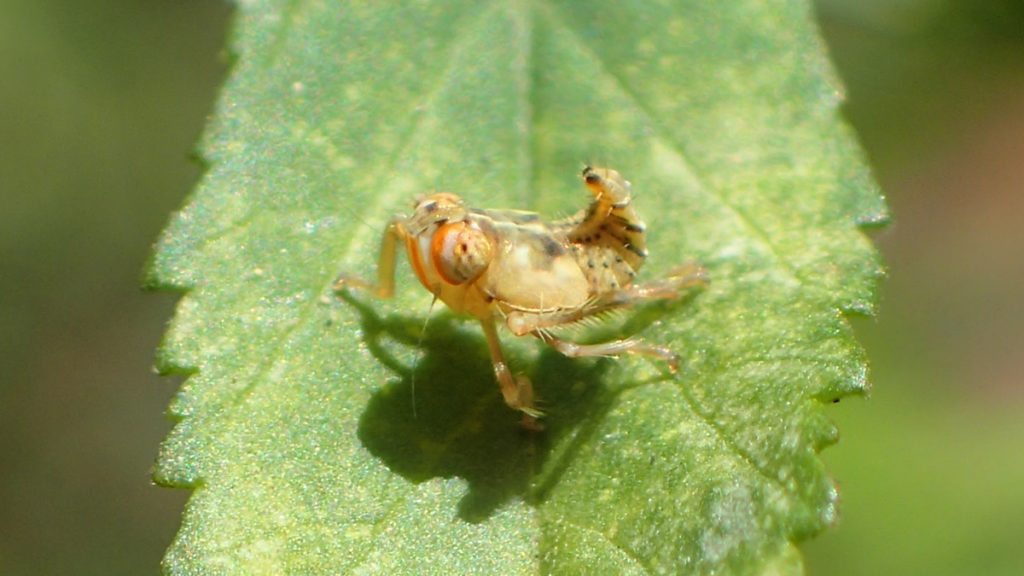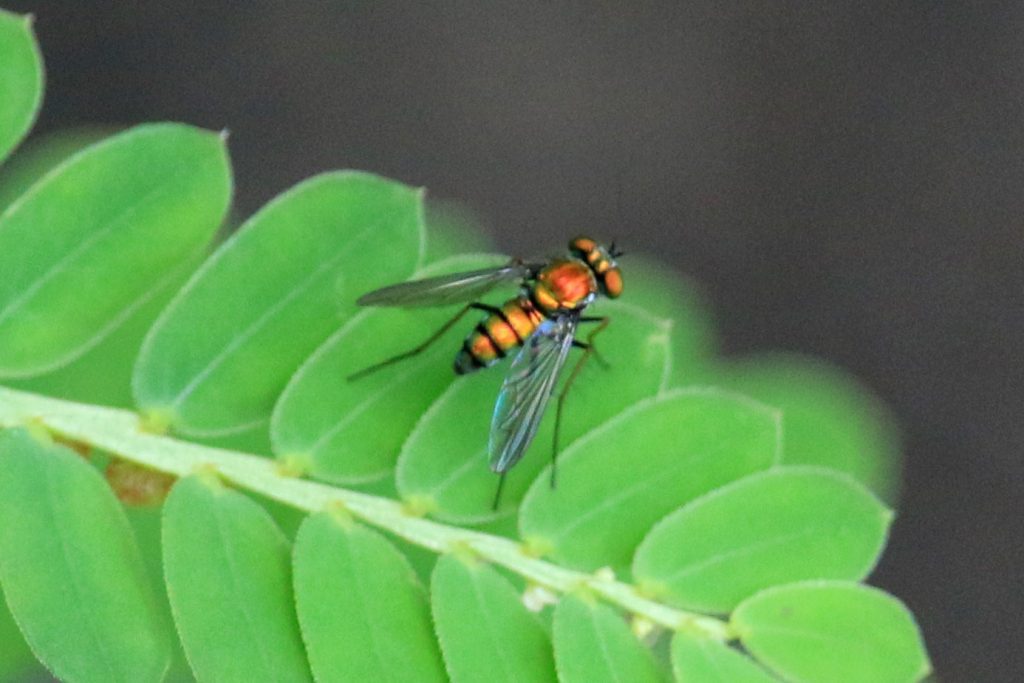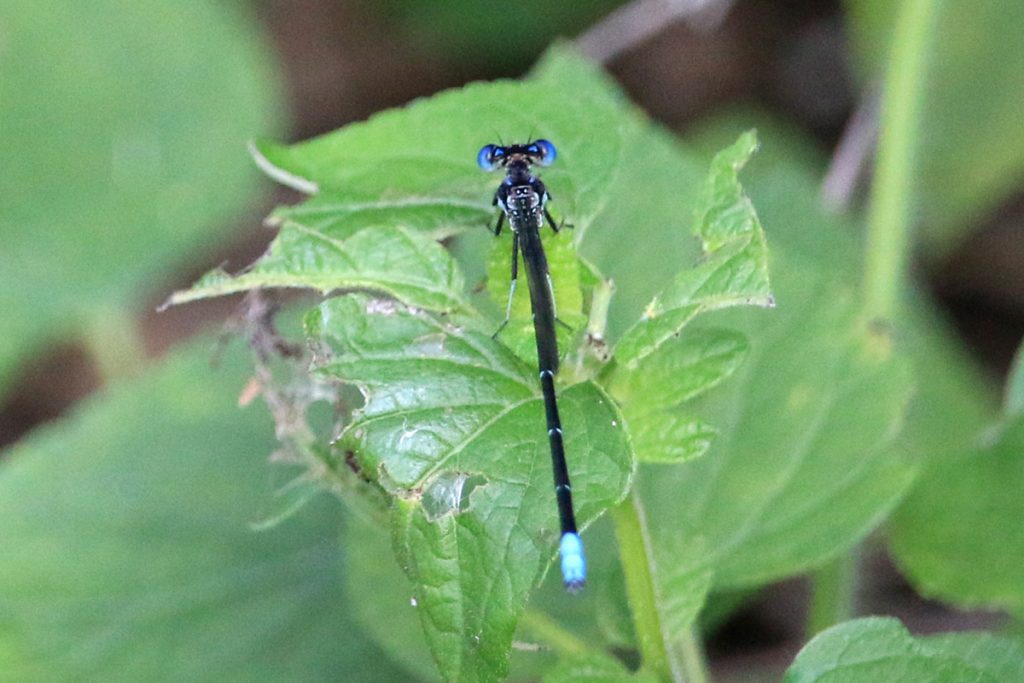In the second half of summer, I’m noticing new plants starting to bloom, and different insects to pollinate them. The personality of the yard is changing with the season.

Blue cardinal flower (Lobelia siphilitica), starting to flower. 
Sunflower bud. 
Brickelia cordifolia, Flyr’s nemesis, starting to flower. 
Dotted horsemint, also known as dotted beebalm (Monarda punctata), starting to flower.
As August progresses, the blue lobelia and dotted horsemint become especially popular with pollinators. I planted the horsemint in the spring, along with several other wildflower species. I had bad luck with most of them, I admit. Some Coreopsis grew along the fence for a few weeks. But the horsemint has been growing steadily all along, in one pot and in one bed. Looking at Facebook posts in wildflower groups, this is when they finally start to bloom.
Check out a sampling of the diversity of visitors this plant, also called beebalm, receives:

Common Eastern Bumble Bee (Bombus impatiens) on dotted horsemint. 
Moth on spotted horsemint, at night. 
Red-marked Pachodynerus Wasp (Pachodynerus erynnis) on dotted horsemint. 
Oriental latrine fly on dotted horsemint.
Even the nonnative fly in that last photo, a species that loves my dog’s poop, is a pollinator. It’s a good reminder to clean up, even if I do enjoy watching dung beetles work.
As for the other plants pictured above, the sunflowers didn’t bloom in August, though the Brickelia get close:
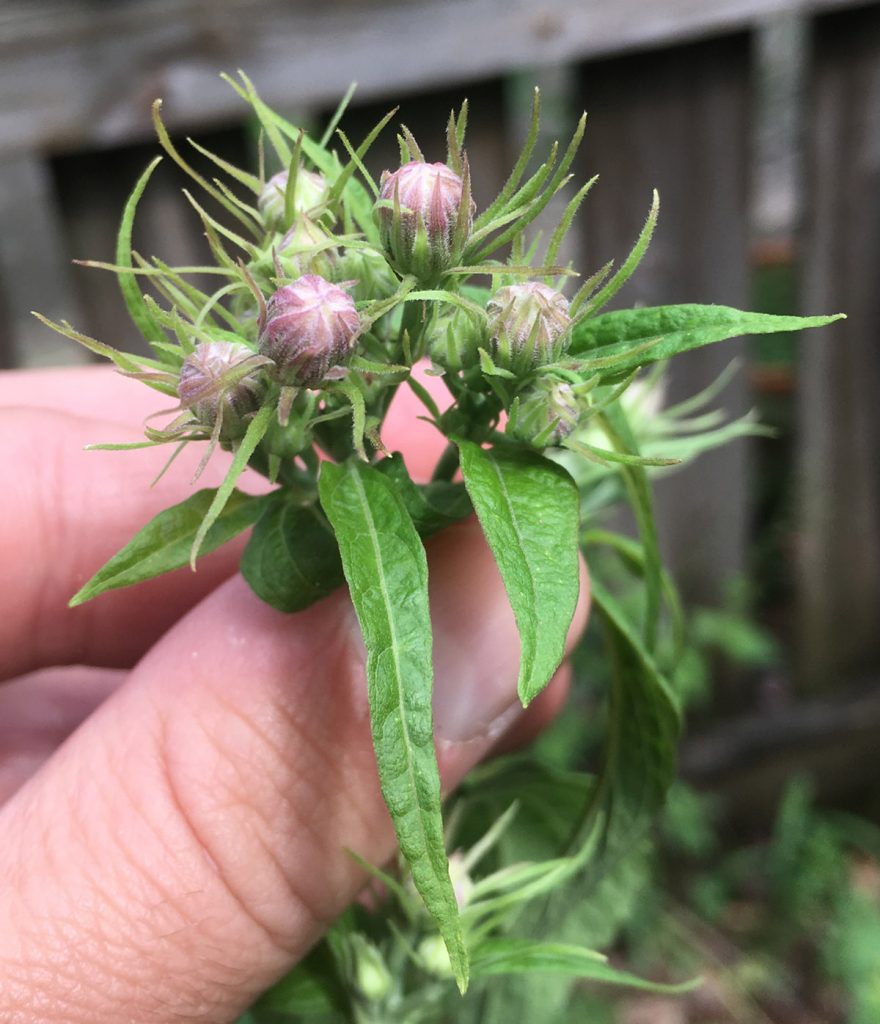
Aside from the horsemint, the plants above are plants I purchased. The Brickelia I bought last year didn’t live more than a few weeks after planting; but they seem to have either reseeded or regrown from the roots in more or less the same spot. So I don’t feel bad about that purchase.
It’s funny, though, that one of the native plants that most captured my interest was, well, kind of a weed.
Fanpetals and Checkered Skippers
Last month I identified a plant I had always seen in my yard, and often weeded out. If you’ve read this blog, though, you know I’ll let stuff grow just to see what it is. This particular plant has a few common names, like Cuban jute or Indian hemp. Sida rhombifolia is in a genus known commonly as fanpetals, and fanpetals are larval food for checkered skippers:
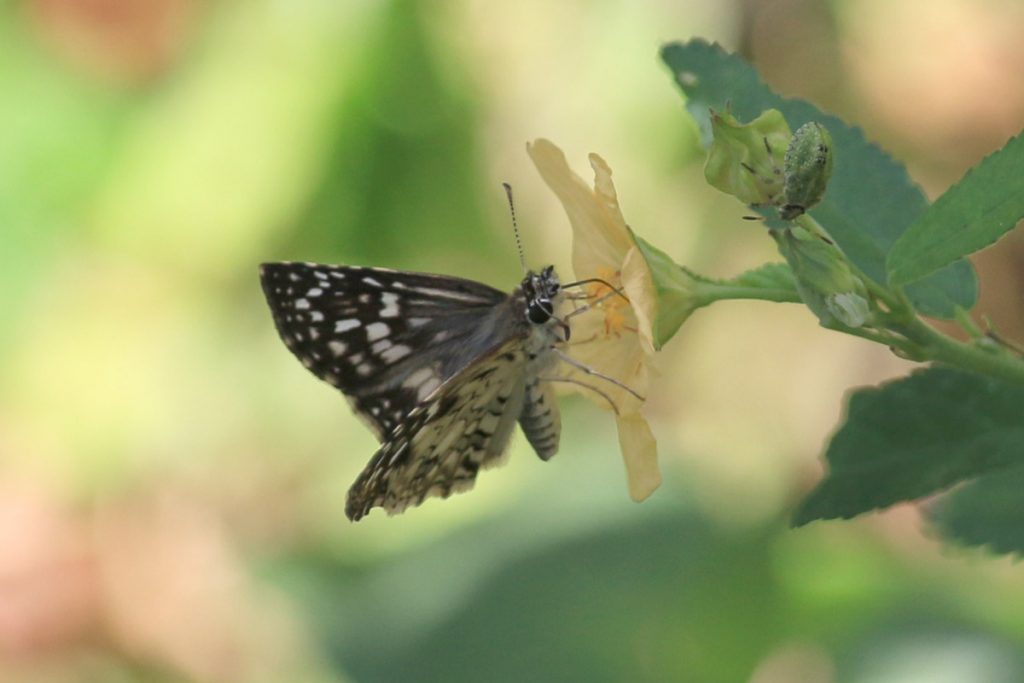
I just noticed that other insect on the leaf next to the fanpetal flower, and I’ll get to that in a second. First, I want to talk about why I identified this as a female tropical-checkered skipper. It’s the upper tip of the wing. The brown and white checkered pattern along the edge of the wing becomes smeared here. You can see it better on another Florida native weed, Florida Pusley, which is a little more out in the sun:
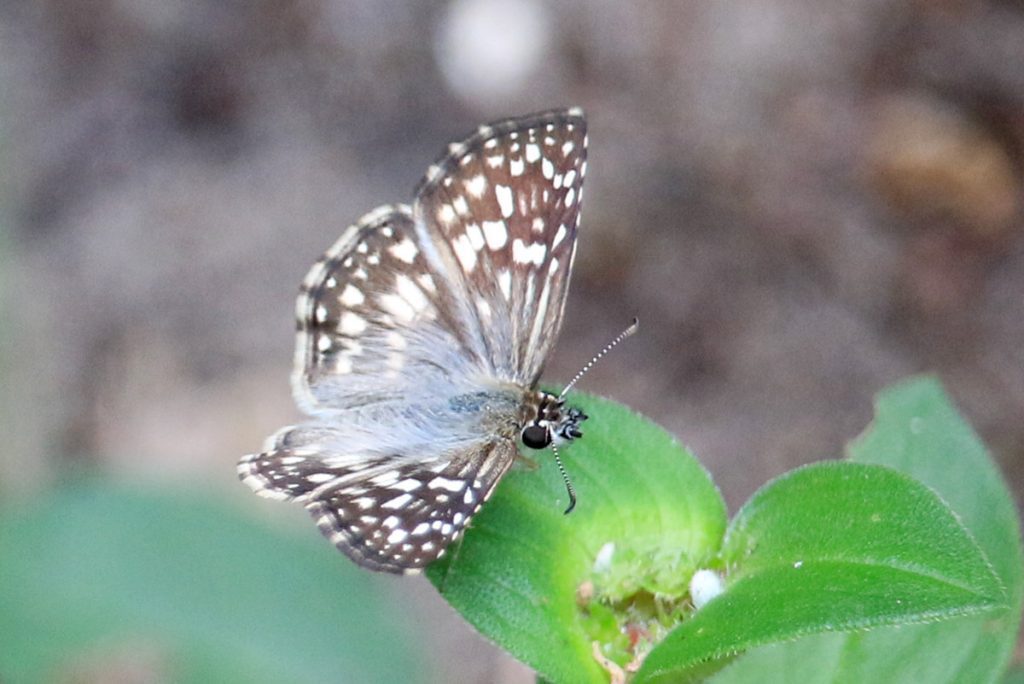
Aside from that smear, it looks like it’s a white-checkered skipper. But as I learned from a commenter on a 2017 post on butterflies, this small smearing gives it away as a female tropical-checkered. And we kind of know this is a female because, well, it looks like it’s laying eggs here:
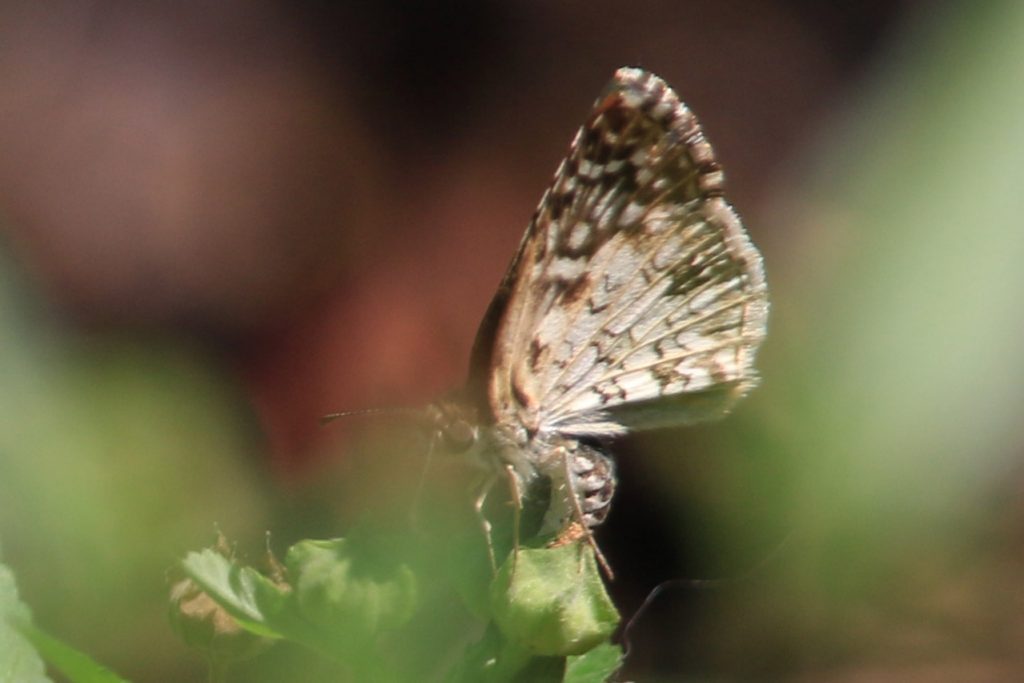
I couldn’t see afterwards if it got an egg into that unopened bud. It does remind me of the frosted elfin, which lays its eggs on new flower growth. The petals grow around the egg, hiding it. And then the caterpillar eats its way out. I’m not saying that this butterfly is trying to get an egg inside the bud, but there is a precedent for something similar.
And it would explain what I saw at Cherokee Lake in Thomasville during this very month. Filming the Great Georgia Pollinator Count there, I shot footage of a wasp tearing open a bud on a fanpetal plant, and removing some kind of insect larva. Wasps of course feed caterpillars to their own larvae. (Look for that video in early November).
Niesthrea louisianica– friend or foe?
I was never able to find caterpillars on the Cuban jute, nor much evidence of eaten leaves or flowers. I did see birds, especially cardinals, perching on its woody stems and pecking at the flowers. Caterpillars are food for so many animals, after all. So I took a closer look.
When I did, I started noticing these little fellows. A lot of them, on a few of the fanpetal plants:
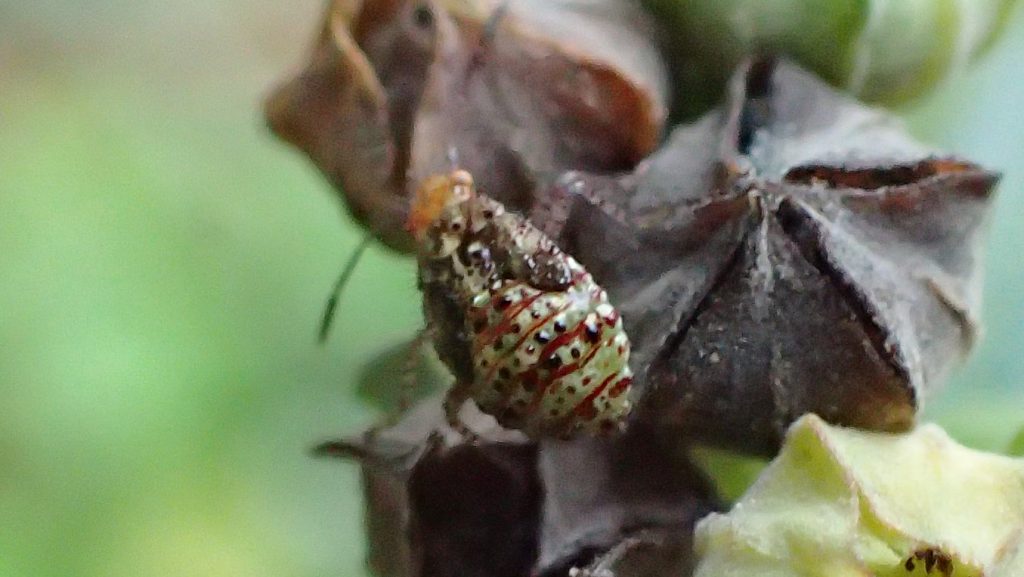
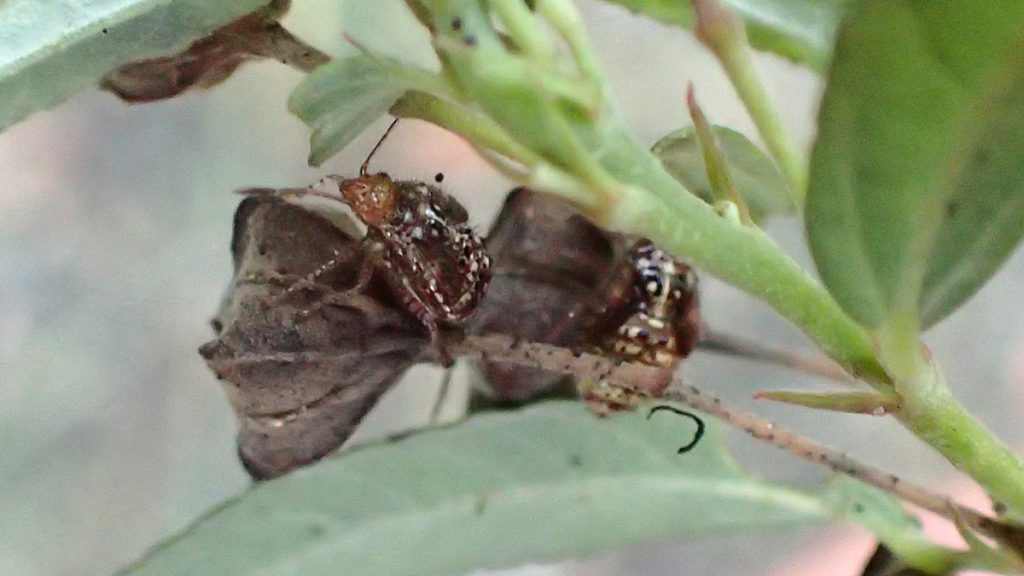
iNaturalist thought this was likely Niesthrea louisianica, and I can see why based on photos. A few days later, I saw the ones below, and iNaturalist gave me the same recommendation:
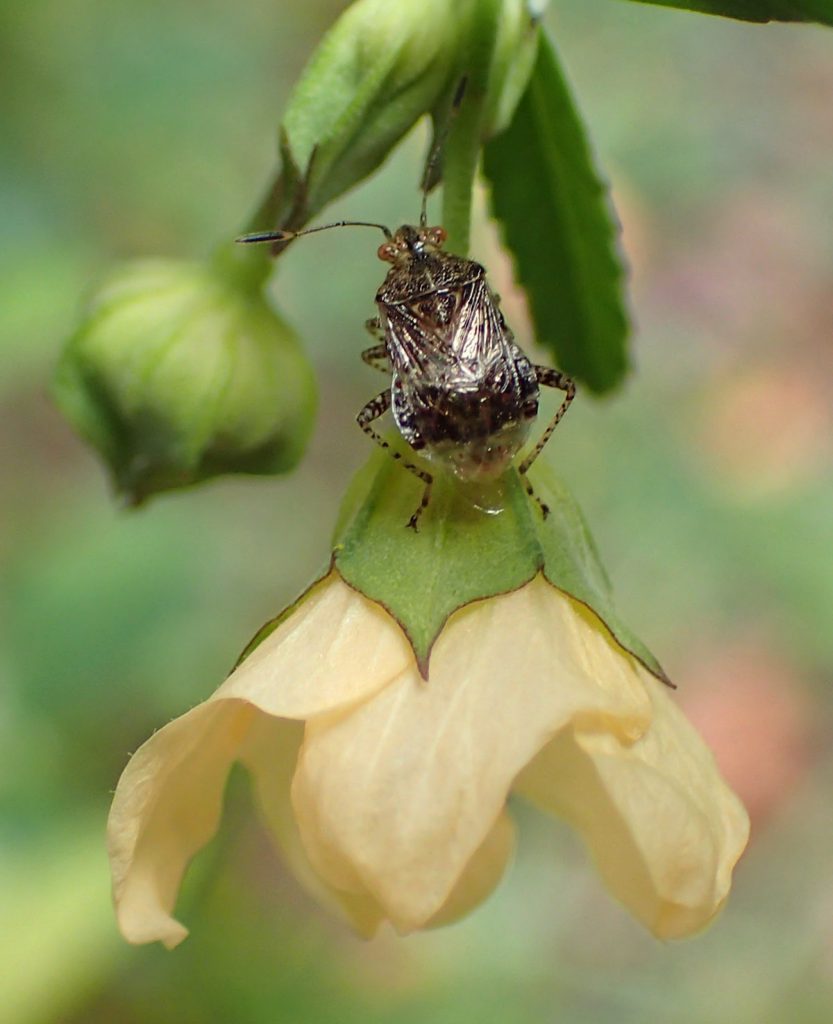
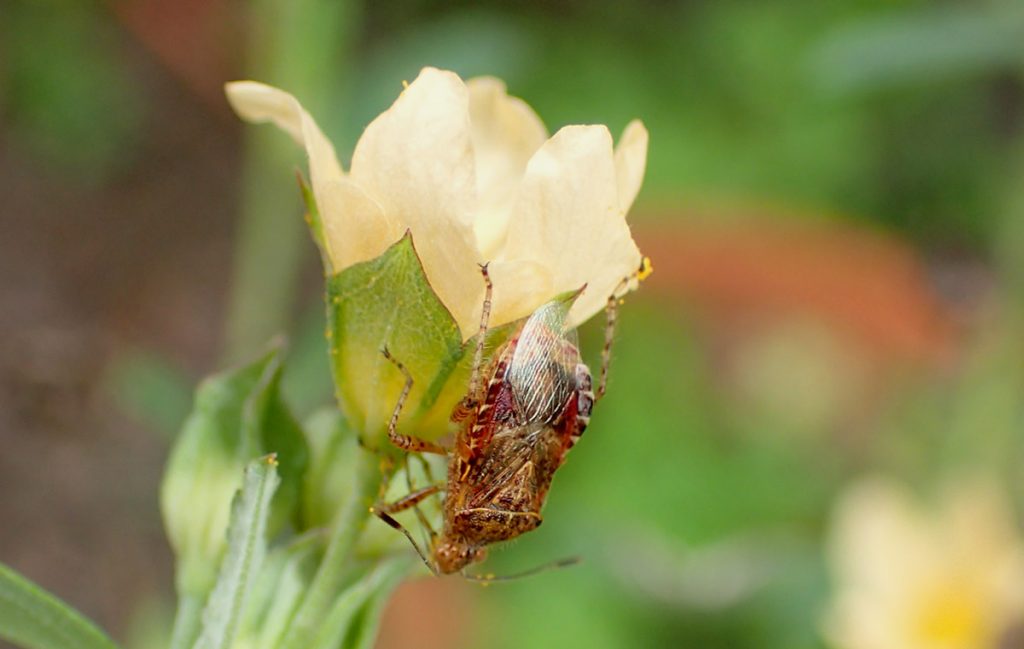
These must be the adult form, and the others some sort of nymph. These insects have no common name; I guess they’re anonymous bird food bugs. Researching further, I see that they’re in the Lygaeidae family, which includes milkweed bugs. Like milkweed bugs, they’re plant consumers.
I’ll point out that fanpetal flowers are about half an inch wide, maybe a little less.
Spartocera fusca, another no (common) named bug
Here’s another bug I thought was neat, and then we’ll get to the pollinators in some more depth. This was on a nightshade weed growing through the fence. It’s a larger, kind of cool looking insect. And yet, no one has bothered to give it a common name. What do you all think it should be called?

Spartocera fusca, a leaf footed bug. 
Spartocera fusca, a leaf footed bug.
Pollinators Part 1: Butterflies
We’ve already seen tropical-checkered skippers. I did see one new butterfly for the year, a sleepy orange:
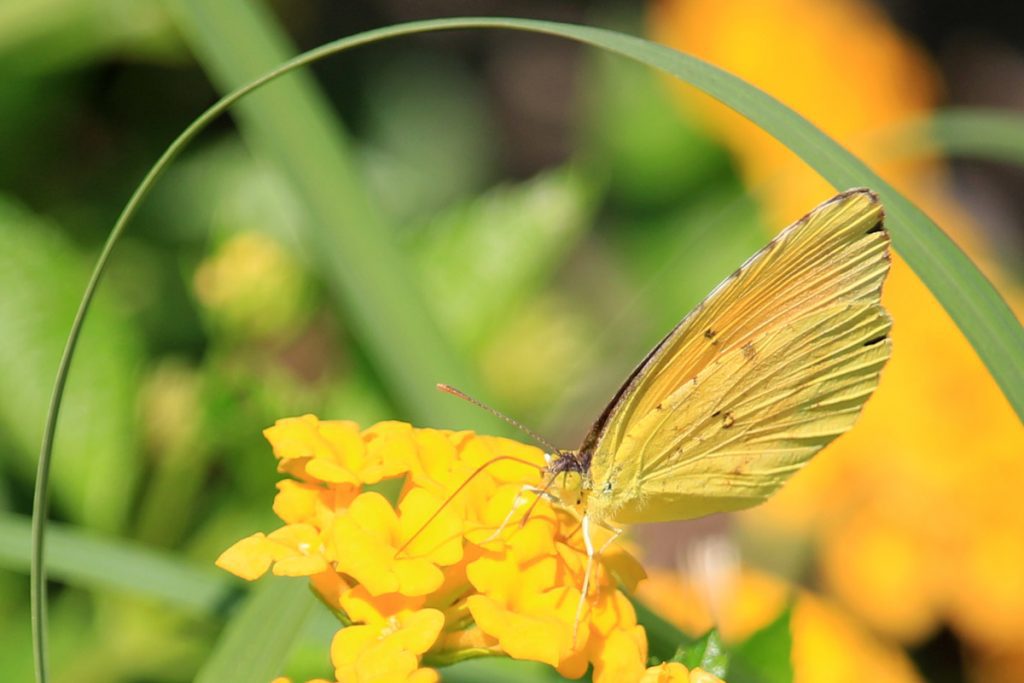
It’s much easier to identify (and harder to photograph) when it’s flying. The underwing does have a superficial resemblance to other yellow butterflies, like cloudless sulfers. But the spot locations line up with sleepy oranges, you can see the black edge of the overwing popping out, and it’s a more saturated yellow than a sulfur.
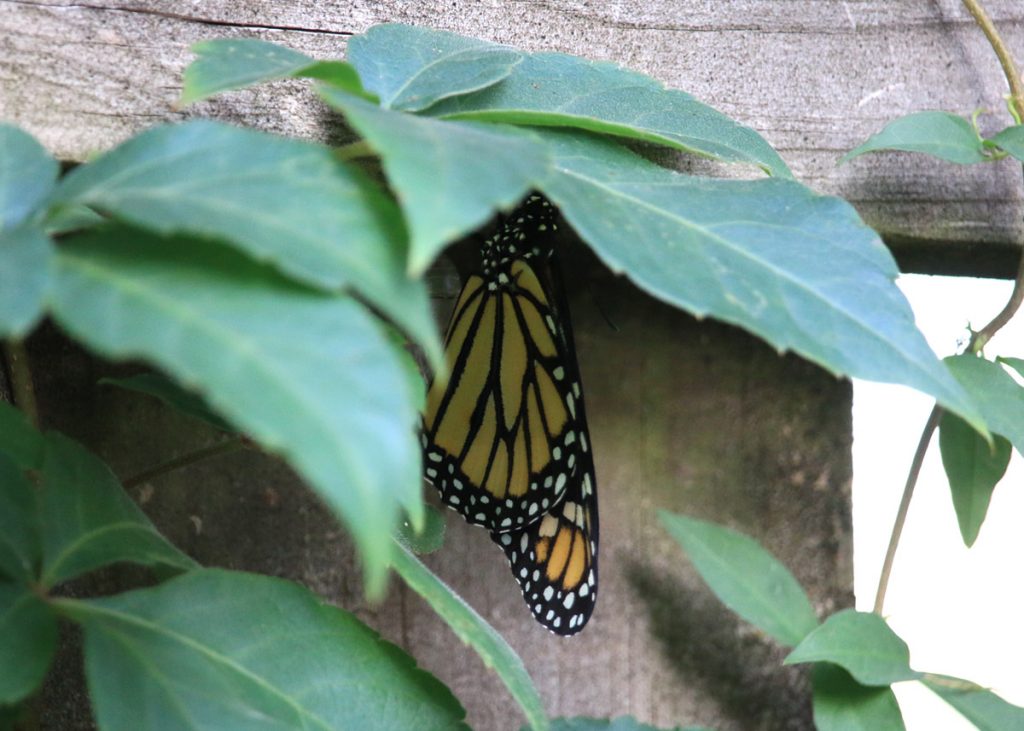
It’s been a weird year for monarch caterpillars in the yard. Quite a few made it to their fifth instar, but then I never saw their chrysalides. Larger caterpillars have eaten a bit of toxic milkweed, and should be less palatable to predators. They tend to survive at higher rates once they’ve gotten bigger. So my hope was that this year’s cats were good at hiding. And here is a monarch hanging from a chrysalis I never saw, hidden by Virginia creeper vine my wife repeatedly told me to clear from the fence.
I did see a zebra longwing and some long-tailed skippers, but it felt like I saw less butterflies overall this month. Maybe this is because we had so many more bees on our flowers? Maybe, maybe not.
My last butterfly observation is of giant swallowtail caterpillars. I’ve documented this process on the blog a time or two, so I won’t spend too much time on it here. But, as we see, the small caterpillars we saw last month got big and began their metamorphosis:

Giant swallowtail (Papilio cresphontes) on lichen covered branch of a Meyer lemon tree. 
A giant swallowtail caterpillar on Meyer lemon leaf. 
Giant swallowtail in its “J” position, about to make a chrysalis. 
Giant swallowtail chrysalis, hanging from Meyer lemon tree.
Pollinators Part 2: Bees
It was a banner month for bees. I’ve never noticed such a diversity of bees in our yard before, for so sustained a period, and in such great numbers. Let’s start with my favorite, of which there may have been 10-12 in the yard at any given time (hard to tell, they move so fast!):
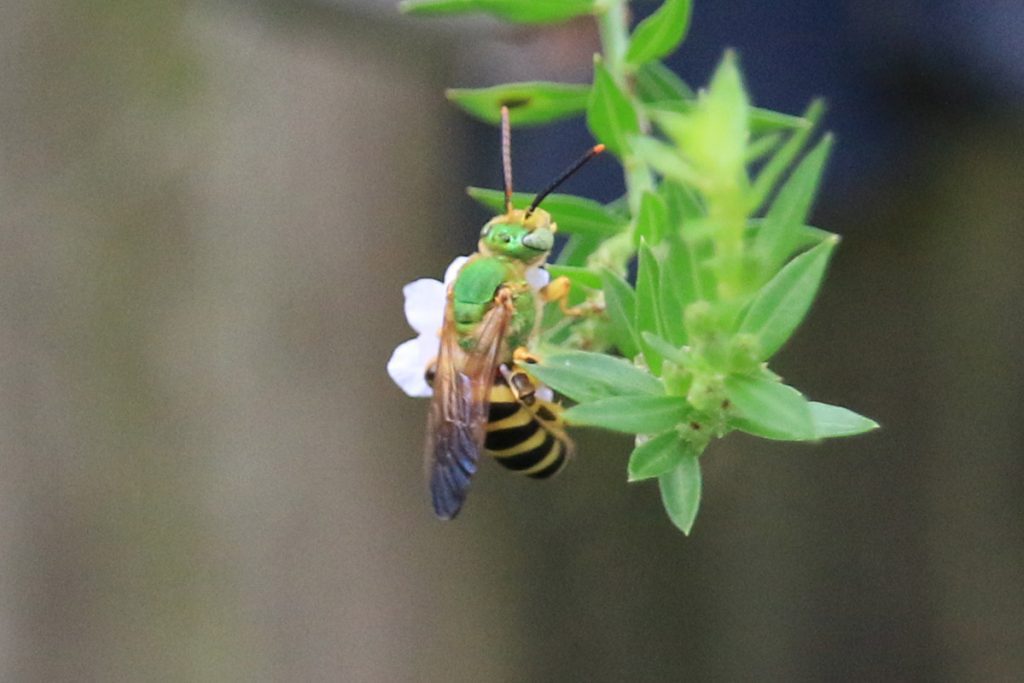
They liked the winged loosestryfe, which has so many tiny flowers. This made them hard to photograph, as they kept bouncing from one to another. So I loved it when I saw one on a purple coneflower:
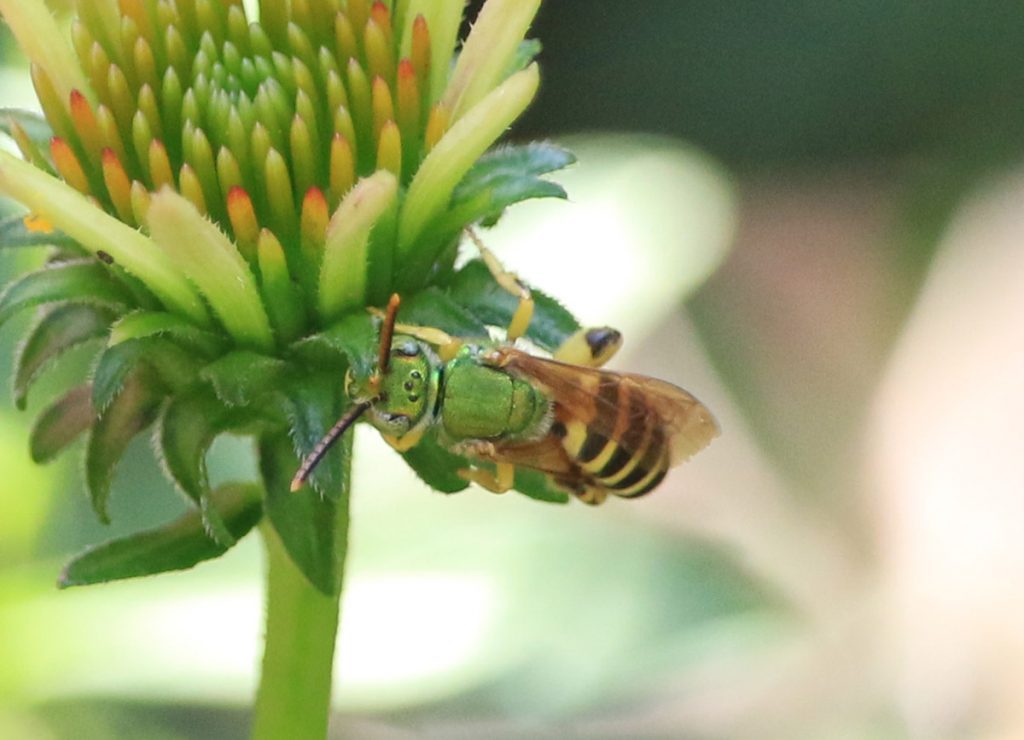
They also liked the blue Lobelia.

A brown-winged Striped Sweat Bee (Agapostemon splendens) on blue lobelia. 
Brown-winged Striped Sweat Bee (Agapostemon splendens) entering blue lobelia flower. 
Brown-winged Striped Sweat Bee (Agapostemon splendens) inside of blue lobelia flower.
These are small bees, which climbed all the way inside of these small blooms.
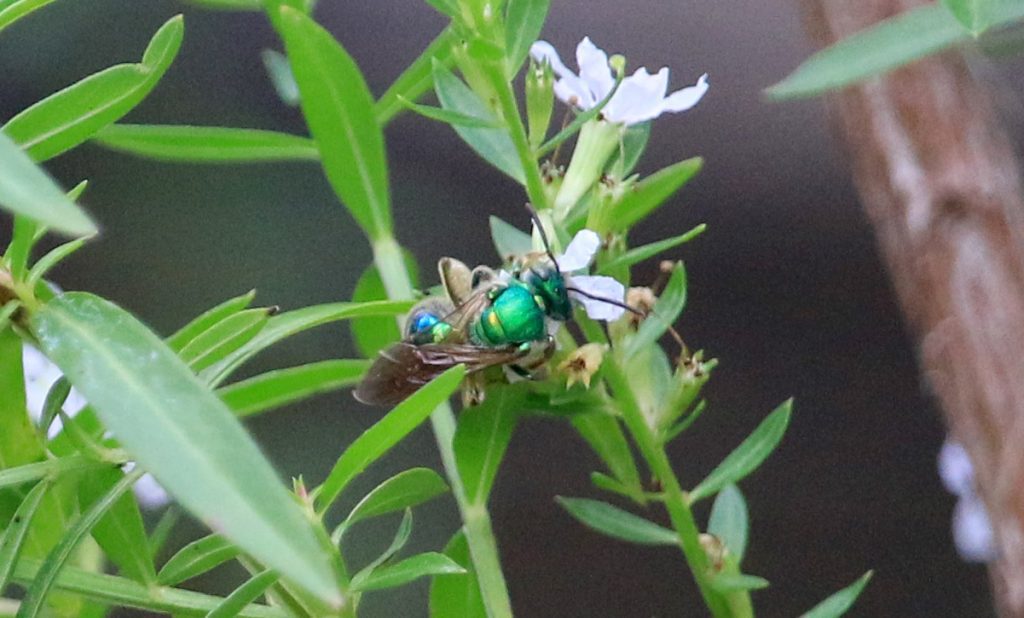
Last month, I spotted my first green metallic sweat bees of the year, apparently looking for a nest on bare ground. Now we always have 2-3, most often on the loosestryfe.
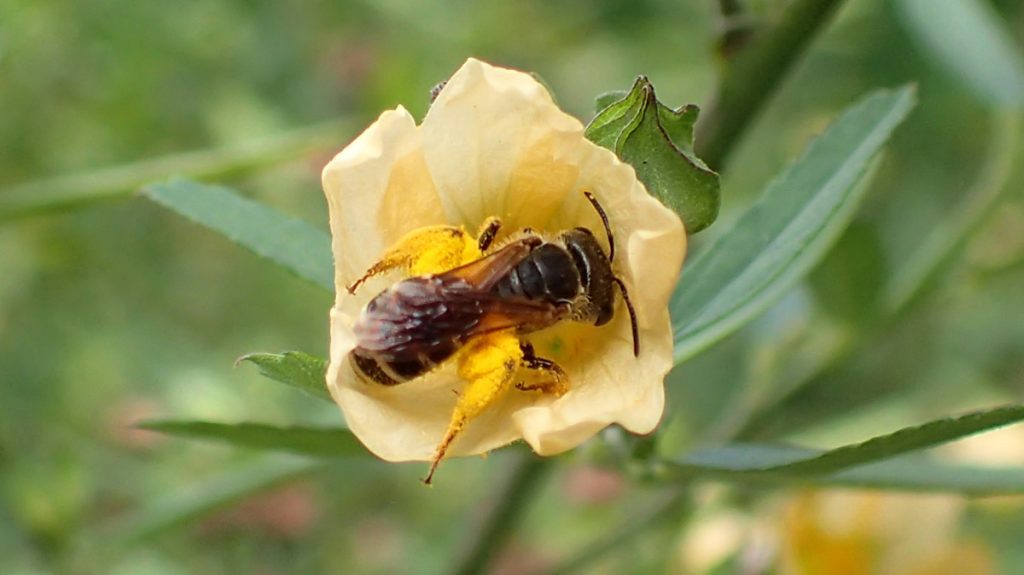
And speaking of small bees, here’s the Poey’s furrow bee. I mentioned the small size of fanpetal flowers earlier. With the naked eye, Poey’s don’t look much like our traditional image of bees. Zoomed in, though, you see the stripes and characteristic head shape, and pollen covered legs.
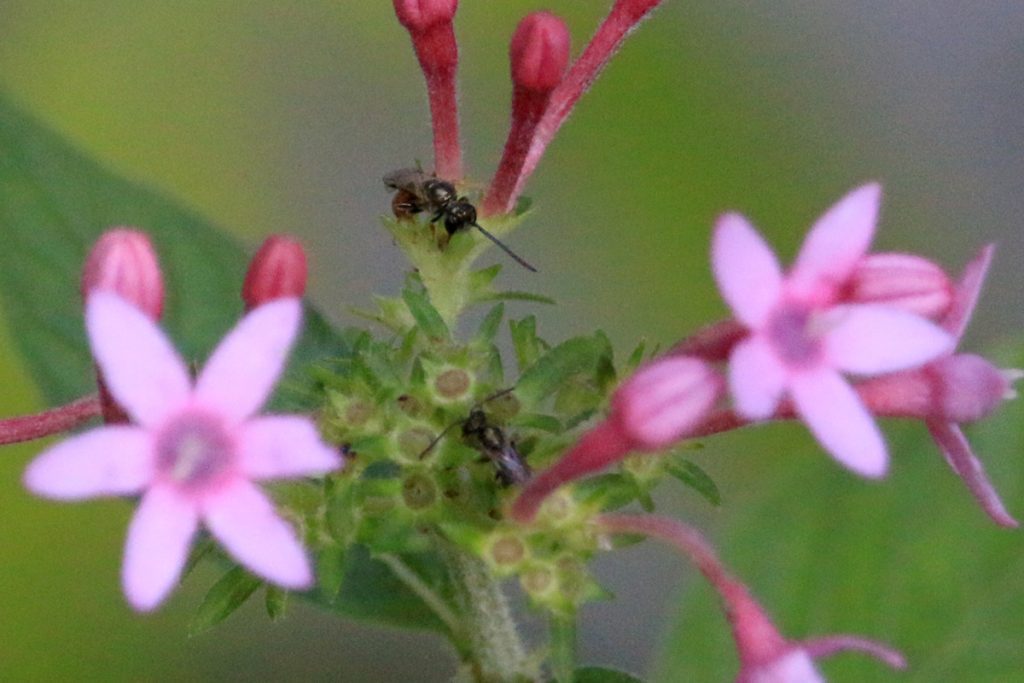
These bees appear to have longer antennae than the Poey’s furrow bees. They’re not clear enough in this photo to upload to iNaturalist (or maybe I should anyway?), but I included them here to show the wide range of bee sizes by contrasting them with the following two bees on the same flowers:
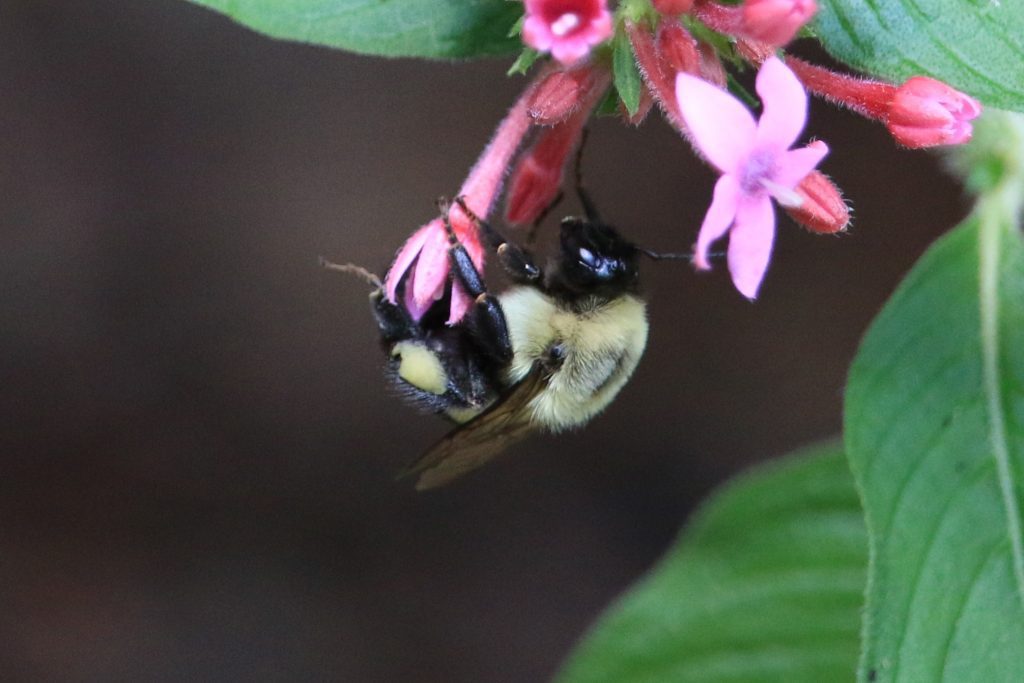
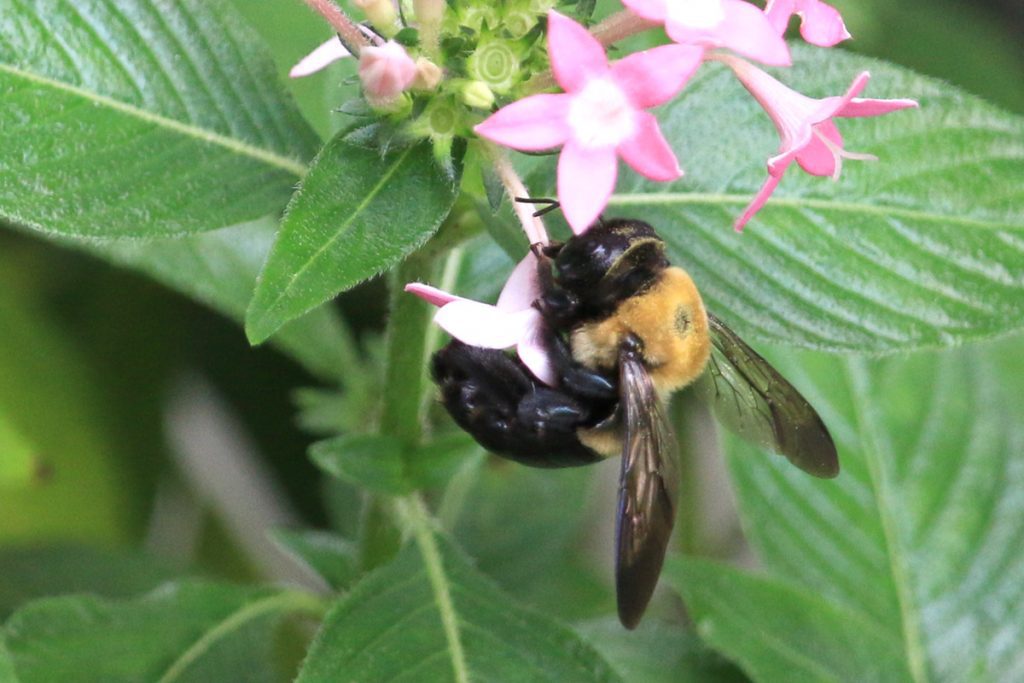
Pollinators Part 3: Wasps
The four-toothed mason wasp has been a common species in our yard the last couple of years. I usually see a solitary wasp that retreats to a small hole in our wooden railing, which I believe was originally made by a carpenter bee. Since the beebalm started blooming though, it seems like I’ve seen more than one at a time in the yard.
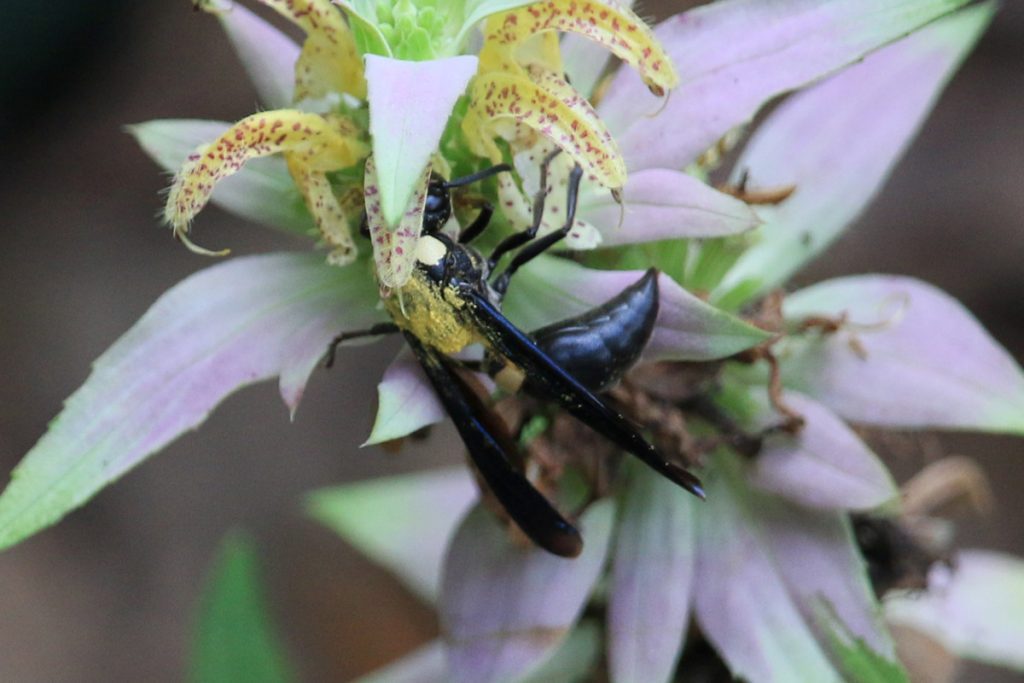
I thought I had a new species of wasp in the yard until I realized the yellow on its back was pollen.
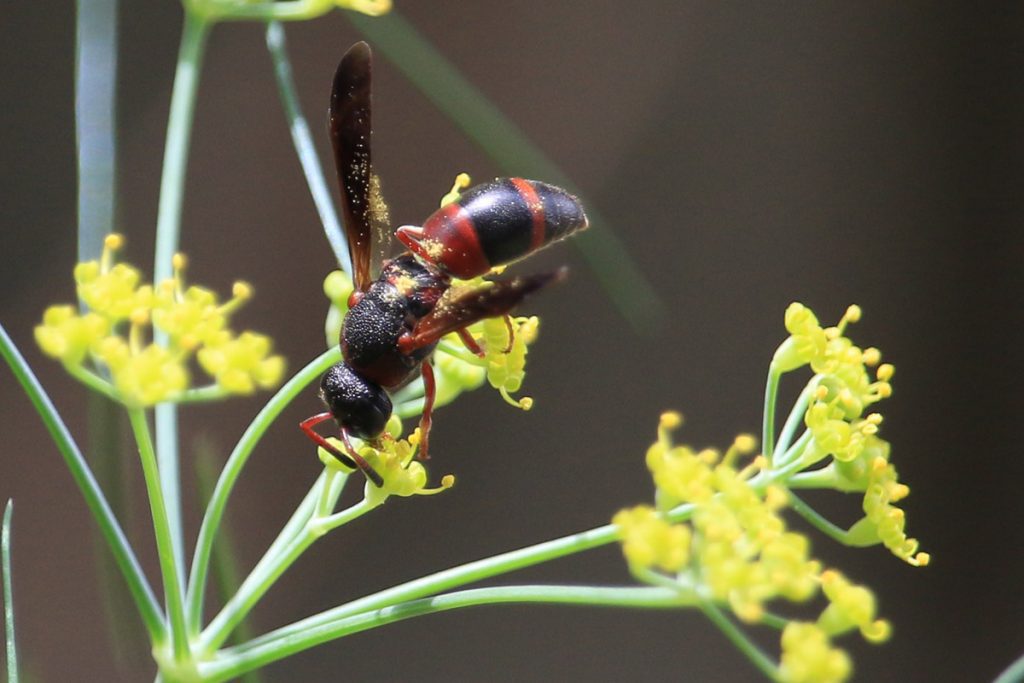
Another regular visitor is the red-marked Pachodynerus wasp, here seen on fennel flowers. And we saw them above on the bee balm. They regularly visit many different flowers in the yard. I’ve also seen them nesting here:
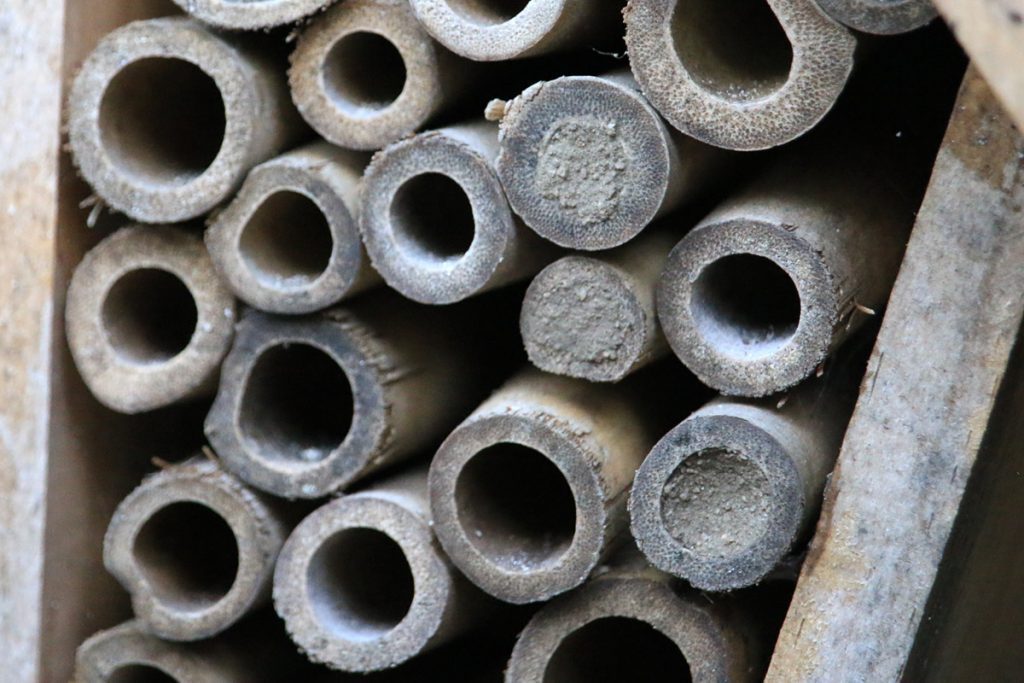
My wife, Amy, bought this bee house as a place for bees to nest. We’ve had plenty of bees in the yard, but many of them are ground nesting bees. Last year and through the spring, I pulled pavers on a large part of the yard, exposing plenty of earth while also adding a flower bed on one end. So this may account for the increase in bees. But I have seen wasps use this bee house. Mason wasps enclose their larvae in cavities, “cementing” them inside with mud.
Pollinators Part 4: Moths
I didn’t photo many moths, but I did see a giant leopard moth caterpillar on a milkweed plant:
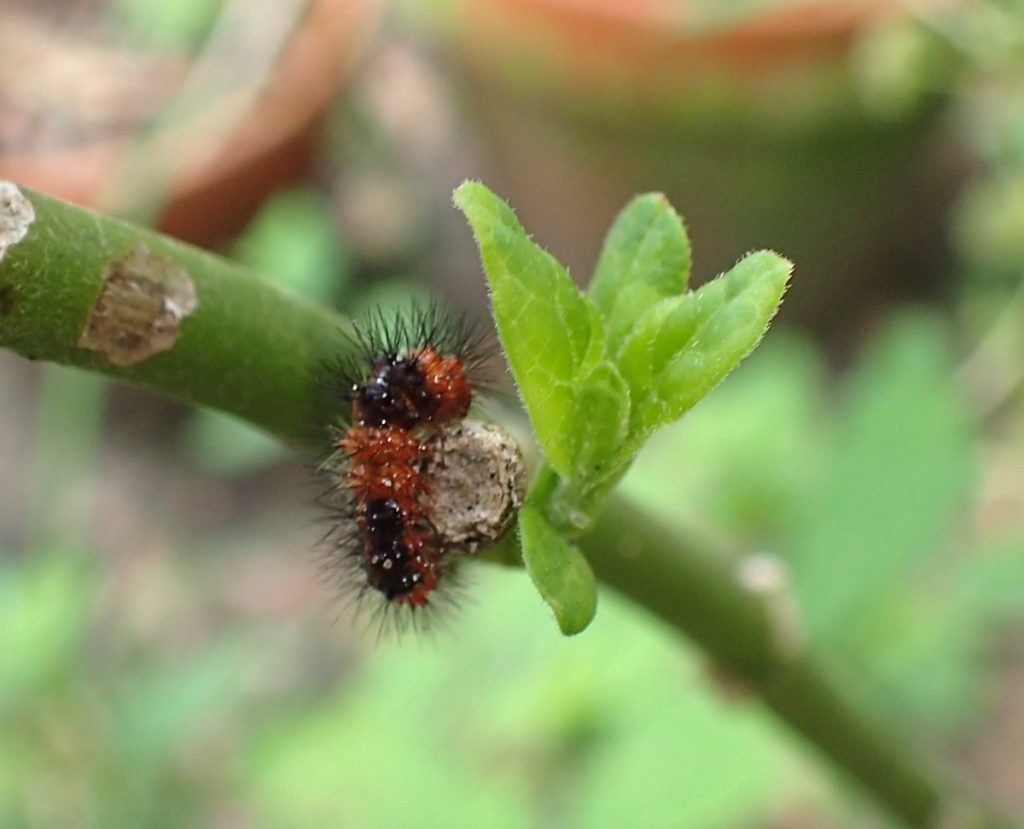
Ive photographed giant leopard moth caterpillars in the yard before, and on multiple species of plant. They’re known to have multiple host plants. I found one blog post by a master gardener in a Cornell Extension office (Ulster County, New York) that says leopard and tiger moth caterpillar species eat milkweed and dogbane to add a toxic sting to their spines. Maybe this is what were seeing here?
Identifying new “weeds” in the yard
iNaturalist has been helpful in identifying insects and plants in the yard, or at least starting me in a direction. Knowing what they are, I can research whether they’re beneficial, detrimental, or just ordinary bugs or plants trying to make their way in the world (of my yard).
Here’s one plant I don’t need help identifying, and I know I don’t want it:
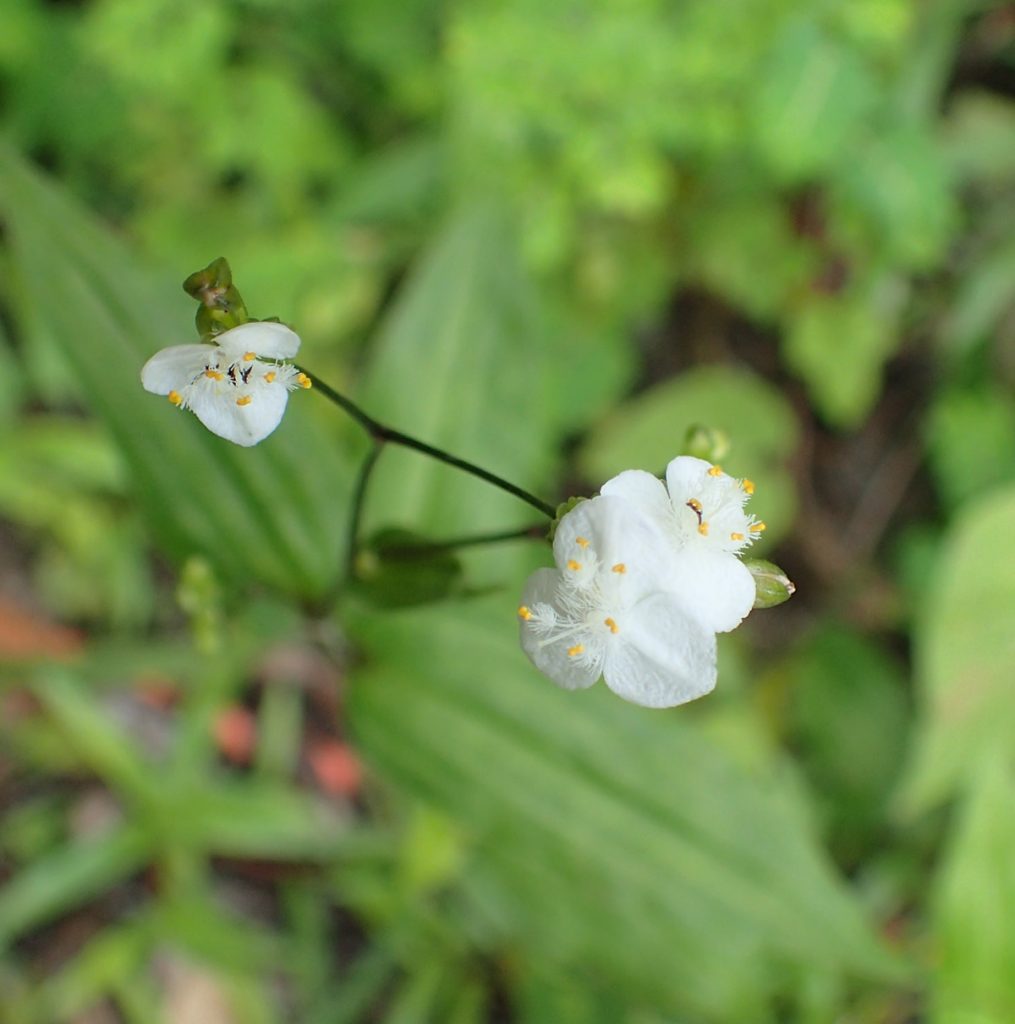
This nasty invasive can take over an area and cover it in a thick mat, crowding out native plants. This one was growing along the fence, and I found it attached to a rhizome on the neighbor’s side, which I pulled out as much as I could. It grew back from under the fence once or twice afterwards. You’ll notice them in some parks (McCord Park had large patches, last time I went), these tiny white flowers that do look kind of pretty when you get up close. When not in bloom, the leaves are distinctive as well:
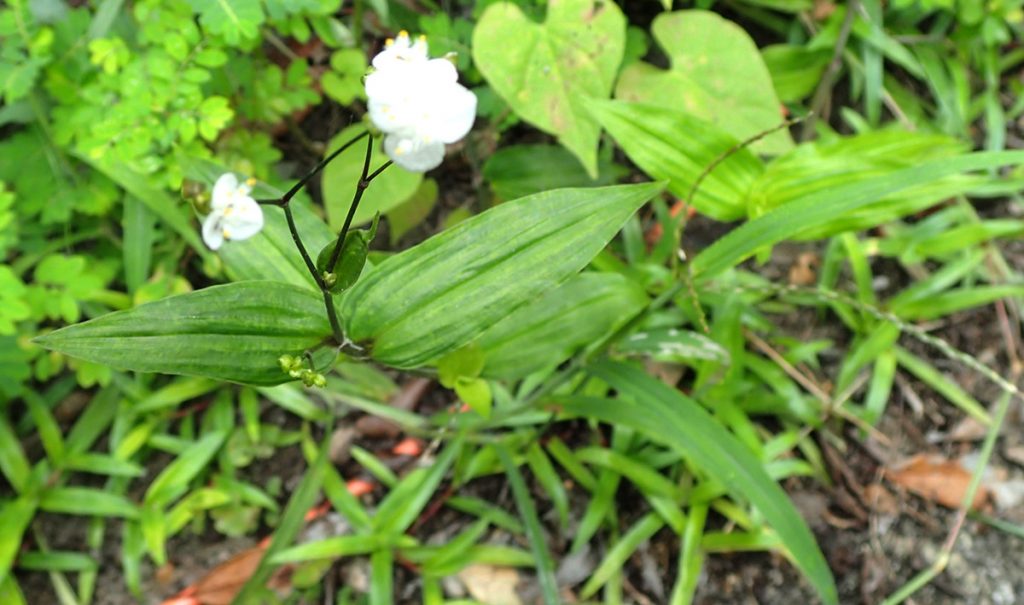
There are also plenty of native spiderworts in the Tradescantia genus, a couple of which are growing in the yard. This next one was a new species on the year:
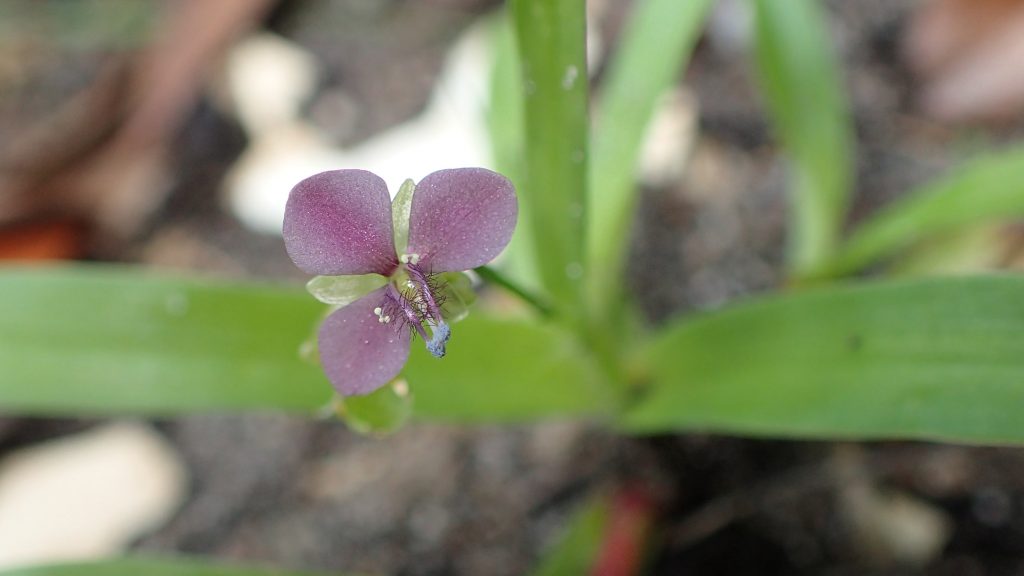
We more regularly have bluejacket (Tradescantia ohiensis).
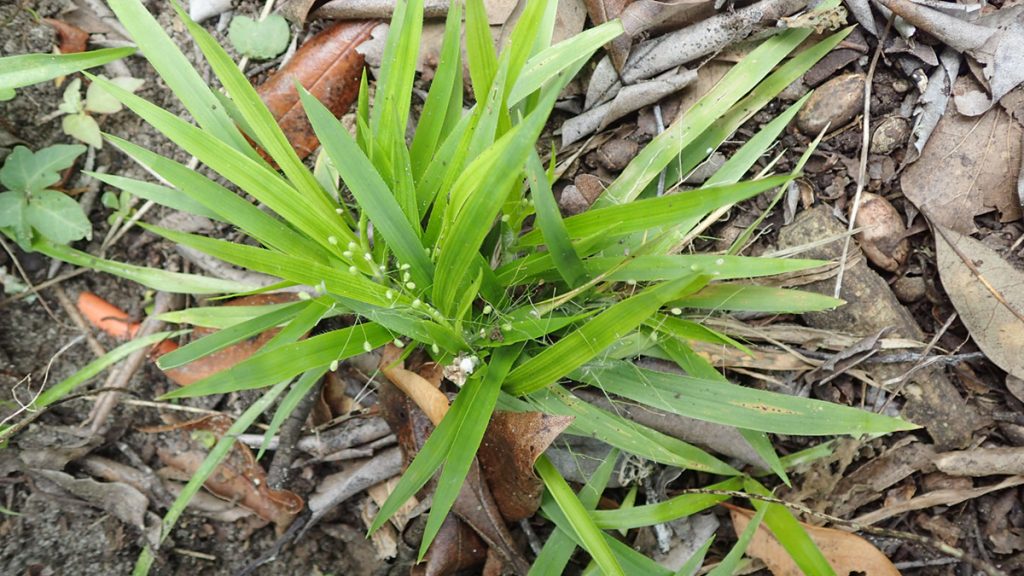
I saw this same type of plant for sale on my Cherokee Lake shoot, labeled as panic grass. That was helpful for me to see, because iNaturalist didn’t immediately recognize it as such. My initial ID was broad-leaved panic grass (Dichanthelium latifolium), though when I clicked the compare button, there were two or three other similar species. All were native to the American southeast.
Odds and ends

Possibly a leaf hopper nymph. 
Long-legged fly (genus Condylostylus) on chamberbitter. 
Blue-ringed Dancer (Argia sedula).
Some random insects I saw in the yard.
This was a fun month to write about, even if I got busy and didn’t get around to writing it until October. Cant wait to write about the weeks of upcoming scorching drought. I really can’t.
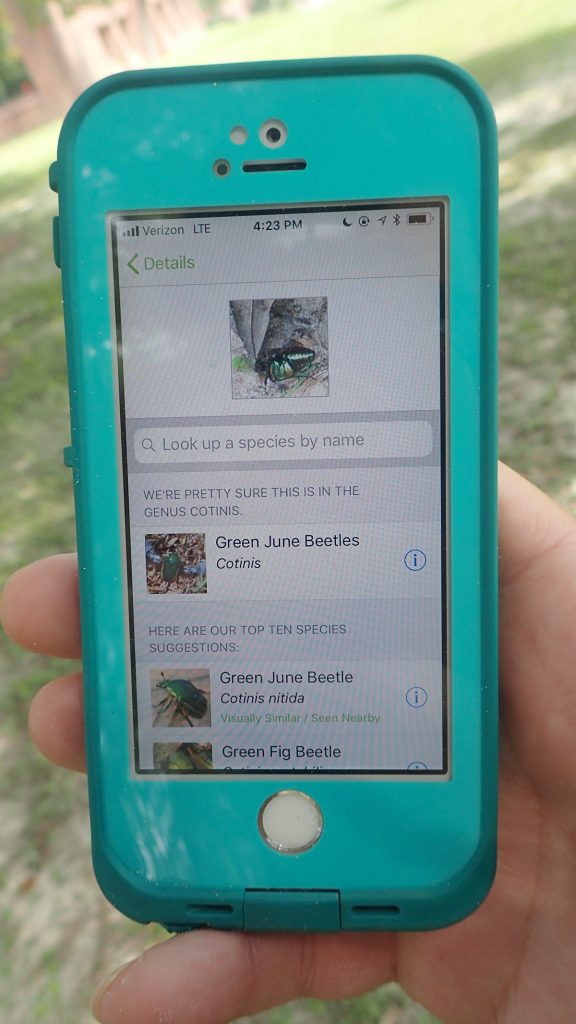
Apps and Citizen Science mentioned in the Backyard Blog
iNaturalist
Identify plants, animals, lichens, and fungi in your yard. Other users correct your identifications if you’re wrong, and even if they don’t, it can be a good springboard to further research.
Seek by iNaturalist
Instant identification, and it doesn’t record your location. This is a good option for kids with phones.
Monarch Larva Monitoring Project
Enter information about monarch caterpillars in your yard, and help researchers get a sense of the health of the monarch population that year, and how and when they’re migrating.
Great Sunflower Project
Record the number of pollinators visiting your flowers, and help researchers map pollinator activity across the country.
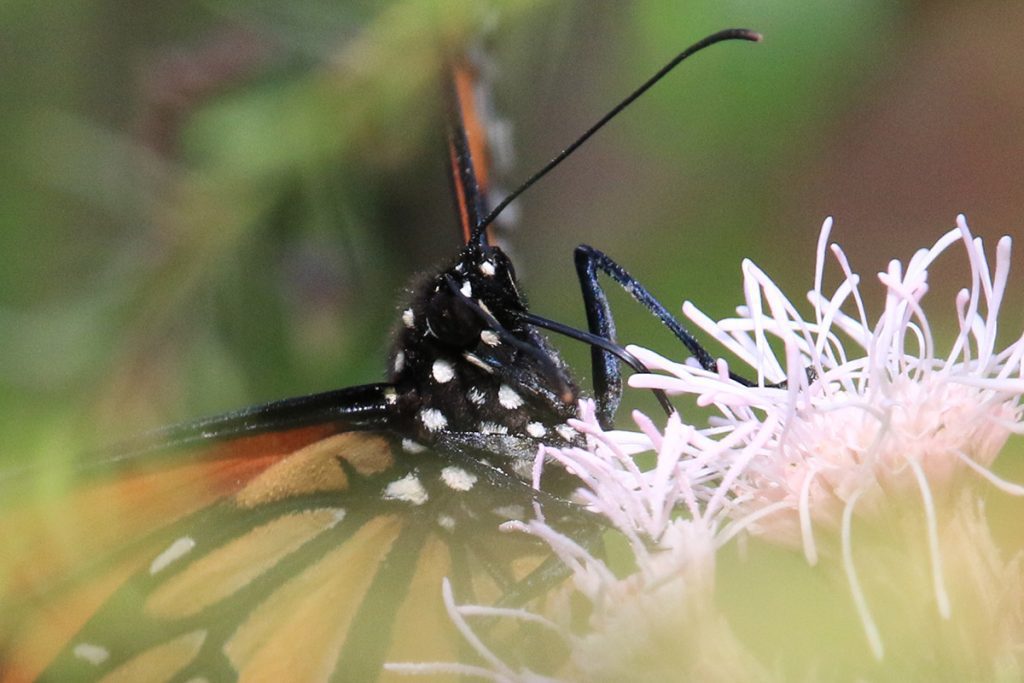
Dig Deeper into Backyard Ecology
What can we do to invite butterflies, birds, and other wildlife into our yards? And what about the flora and fauna that makes its way into our yards; the weeds, insects, and other critters that create the home ecosystem? WFSU Ecology Blog takes a closer look.


